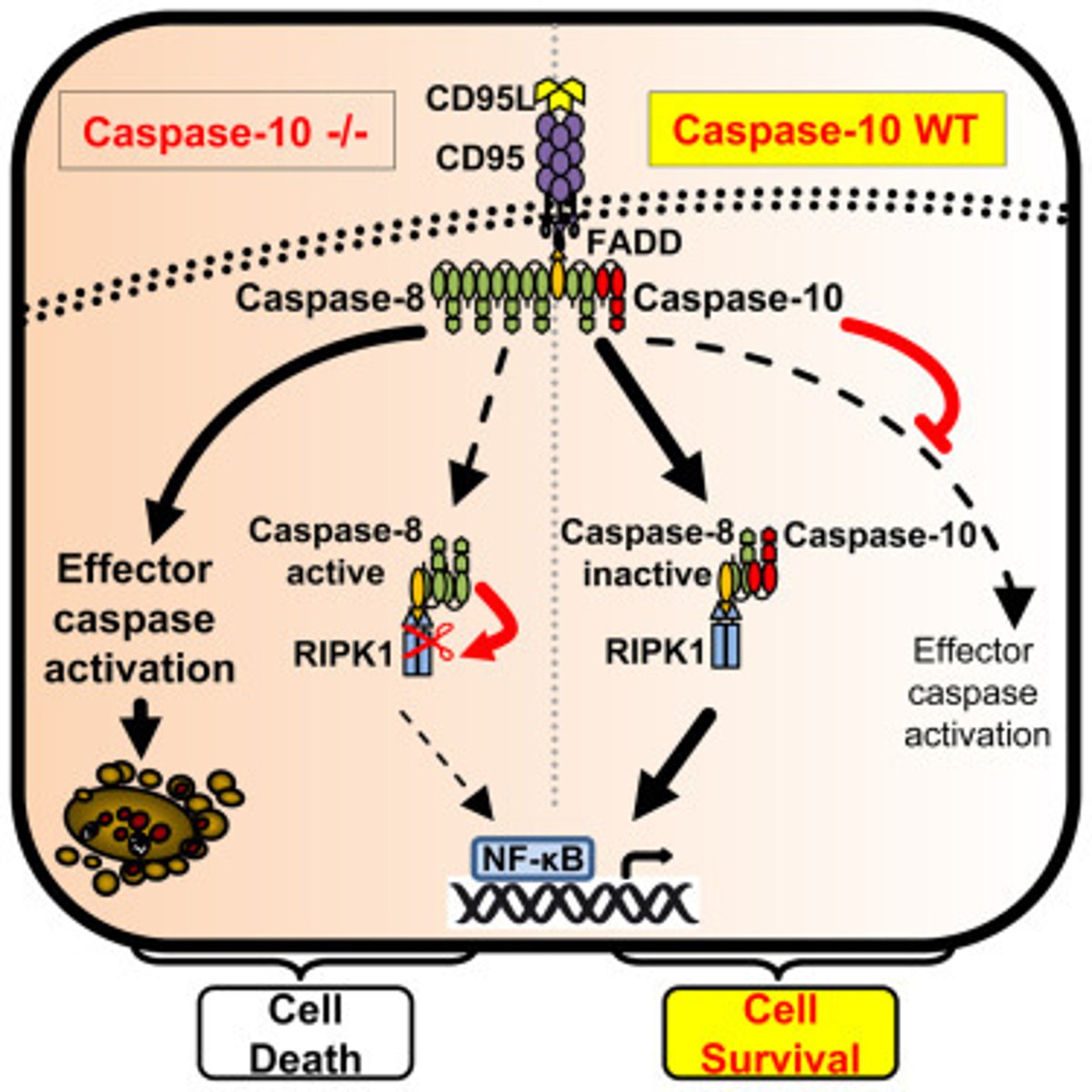Biochemistry II Module of the MCAT Self Prep eCourse: Lesson 2: Citric Acid Cycle and The Electron Transport Chain (Pro)
1/54
There's no tags or description
Looks like no tags are added yet.
Name | Mastery | Learn | Test | Matching | Spaced |
|---|
No study sessions yet.
55 Terms
Lesson 2: Citric Acid Cycle and The Electron Transport Chain
Lesson 2: Citric Acid Cycle and The Electron Transport Chain
During Cellular Respiration, energy intermediates are created that can be oxidized to generate ATP. During what stages are these intermediates produced?
I. Glycolysis
II. The Linking Step (Pyruvate Dehydrogenase)
III. Kreb's Cycle
(A) I and II Only
(B) I and III Only
(C) II and III Only
(D) I, II, and III
(D) I, II, and III
Glycolysis generates NADH. The linking step generates NADH. The citric acid cycle, or Krebs cycle, generates NADH and FADH2. These intermediates donate their electrons to the electron transport, generating ATP.
Struggling to memorize the metabolic pathways (such as glycolysis and beta-oxidation)? Learn them like the back of your hand using Andrew's Metabolic Pathways Mastery Course @ https://mcatselfprep.com/course/andrews-metabolic-pathways-mastery-course/
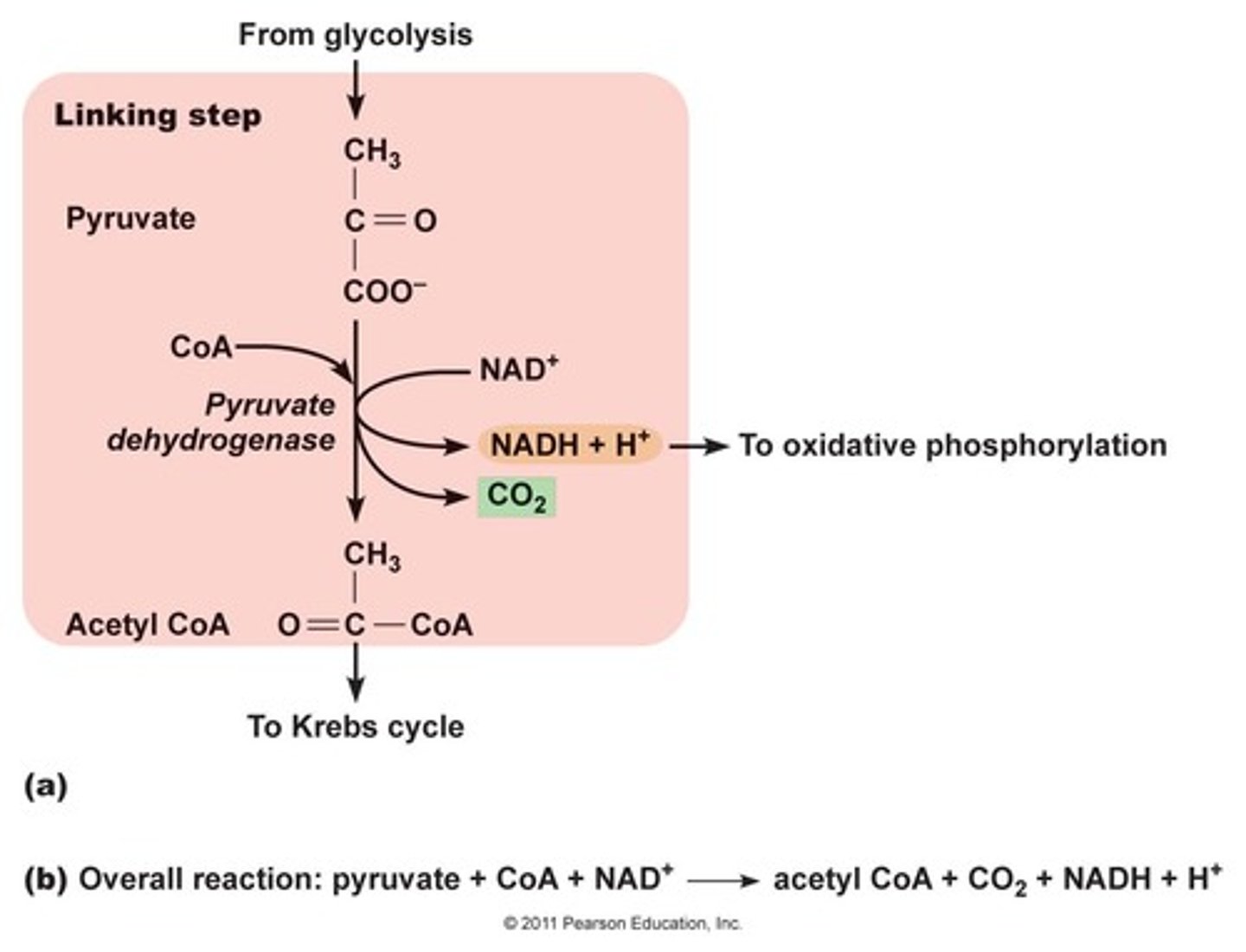
CRB The Krebs Cycle can go by many other names. Which of the following is NOT synonymous with the Krebs Cycle?
(A) Citric Acid Cycle
(B) Tricarboxylic Acid Cycle
(C) Crassulacean Acid Cycle
(D) TCA Cycle
(C) Crassulacean Acid Cycle
The Kreb's Cycle can also be called:
(A) Citric Acid Cycle
(B) Tricarboxylic Acid Cycle
(D) TCA Cycle
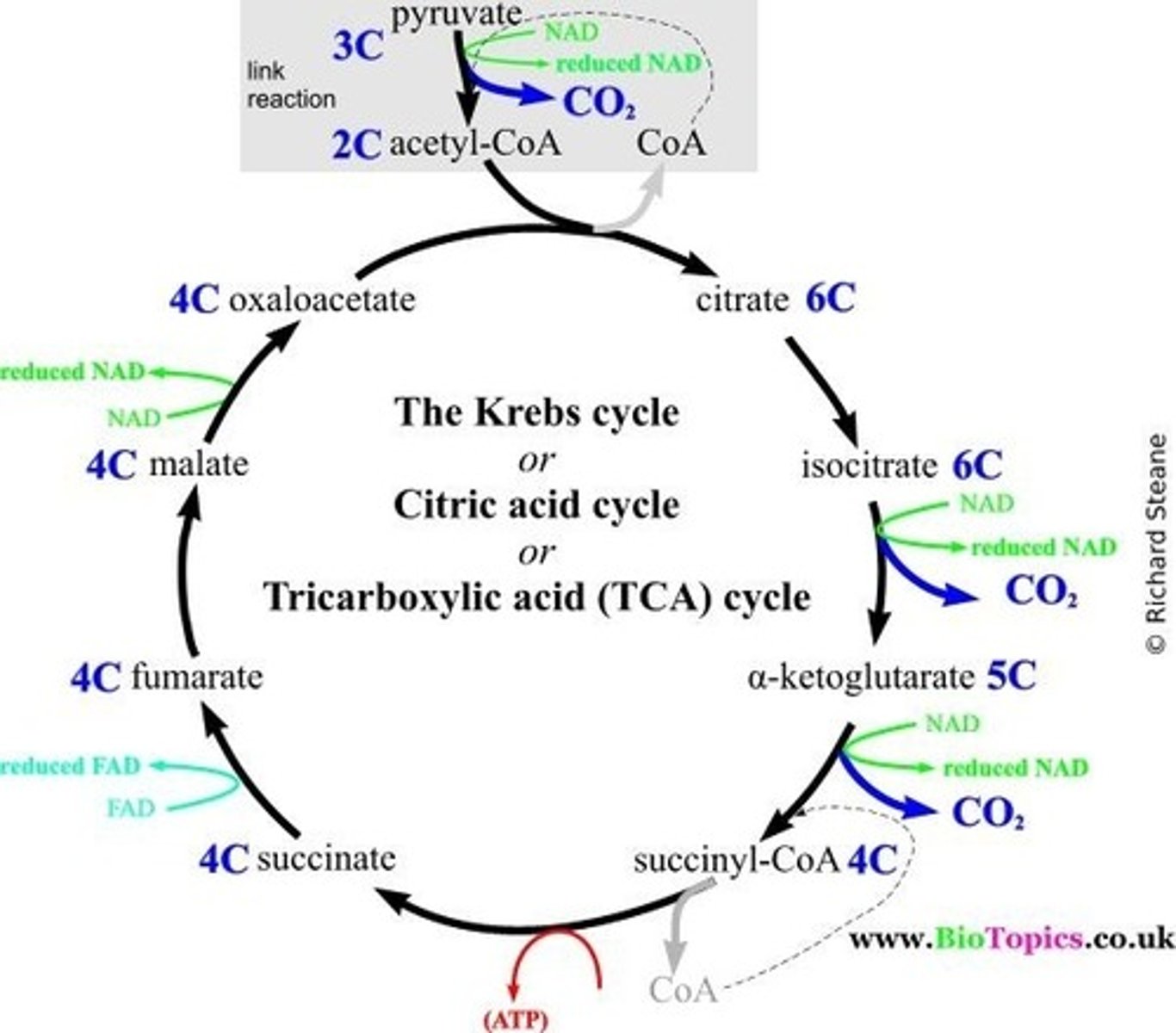
During cellular respiration, in which cellular locations is NADH produced?
I. Cytosol
II. Mitochondria
III. Endoplasmic Reticulum
(A) I Only
(B) II Only
(C) I and II Only
(D) II and III Only
(C) I and II Only
NADH is produced in the cytosol (during glycolysis) and the mitochondrial matrix (during the Kreb's cycle).
Struggling to memorize the metabolic pathways (such as glycolysis and beta-oxidation)? Learn them like the back of your hand using Andrew's Metabolic Pathways Mastery Course @ https://mcatselfprep.com/course/andrews-metabolic-pathways-mastery-course/
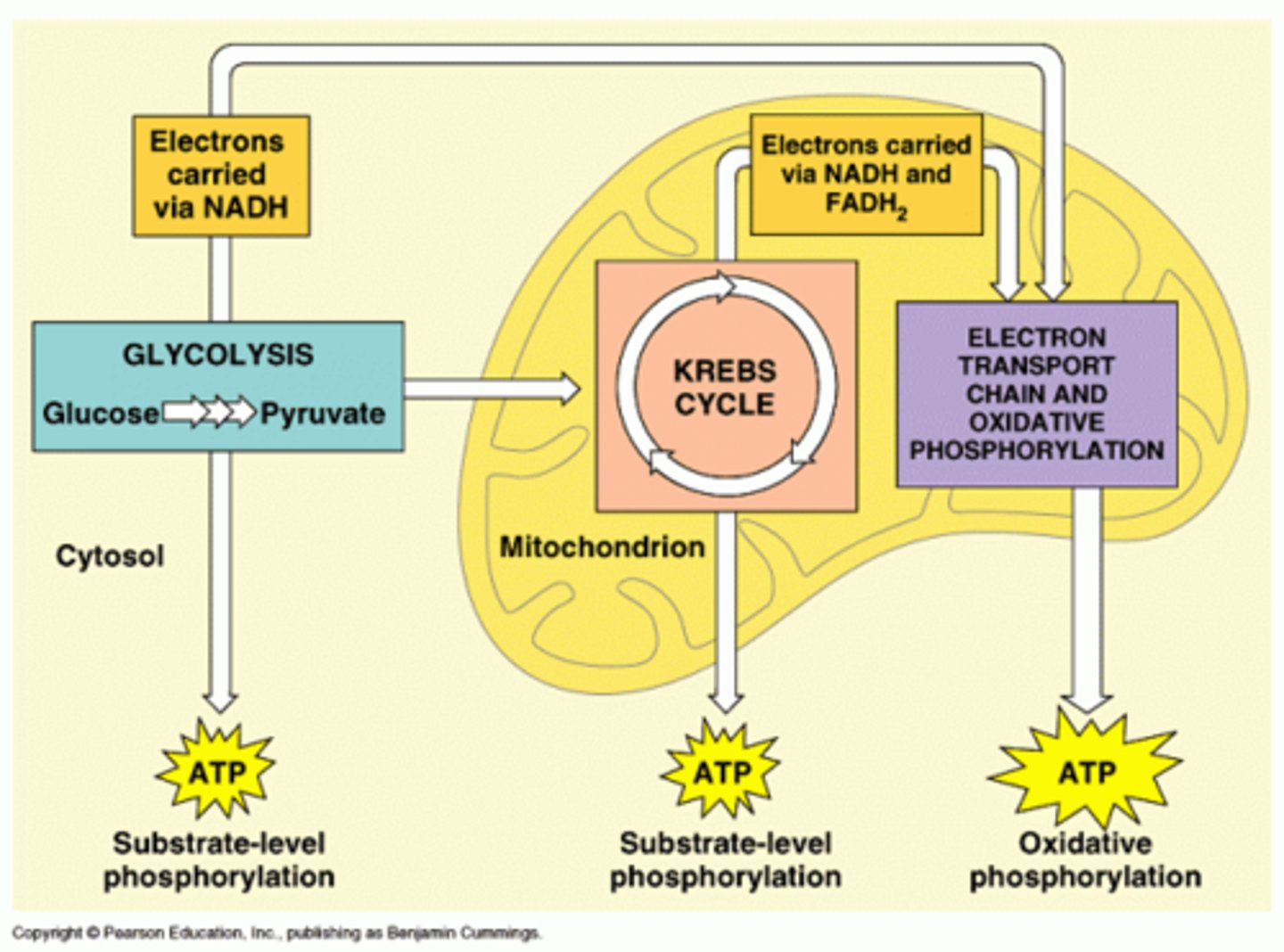
During each stage of cellular respiration, state how many net ATP/GTP, NADH, and FADH2 molecules are produced per molecule of glucose?
(1) Glycolysis
(2) The Linking Step (Pyruvate Dehydrogenase)
(3) Kreb's Cycle
(1) Glycolysis - 2 ATP, and 2 NADH
(2) The Linking Step (Pyruvate Dehydrogenase) - 2 NADH
(3) Kreb's Cycle - 2 GTP [similar to ATP], 6 NADH, and 2 FADH2
In total: 4 ATP/GTP, 10 NADH, 2 FADH2
Struggling to memorize the metabolic pathways (such as glycolysis and beta-oxidation)? Learn them like the back of your hand using Andrew's Metabolic Pathways Mastery Course @ https://mcatselfprep.com/course/andrews-metabolic-pathways-mastery-course/
![<p>(1) Glycolysis - 2 ATP, and 2 NADH</p><p>(2) The Linking Step (Pyruvate Dehydrogenase) - 2 NADH</p><p>(3) Kreb's Cycle - 2 GTP [similar to ATP], 6 NADH, and 2 FADH2</p><p>In total: 4 ATP/GTP, 10 NADH, 2 FADH2</p><p>Struggling to memorize the metabolic pathways (such as glycolysis and beta-oxidation)? Learn them like the back of your hand using Andrew's Metabolic Pathways Mastery Course @ https://mcatselfprep.com/course/andrews-metabolic-pathways-mastery-course/</p>](https://knowt-user-attachments.s3.amazonaws.com/78f6ca3d-1c8a-4164-b120-efd1a5ea42fb.jpg)
During glycolysis, glucose is broken in half, forming 2 pyruvate molecules. Then during the linking step, one pyruvate loses ___ of its carbons as CO2. During the Kreb's cycle, one pyruvate loses ___ of its carbons as CO2.
(A) 1, 1
(B) 1, 2
(C) 0, 3
(D) 2, 1
(B) 1, 2
During the linking step, one pyruvate loses 1 of its carbons as CO2. During the Kreb's cycle, one pyruvate loses 2 of its carbons as CO2.
Struggling to memorize the metabolic pathways (such as glycolysis and beta-oxidation)? Learn them like the back of your hand using Andrew's Metabolic Pathways Mastery Course @ https://mcatselfprep.com/course/andrews-metabolic-pathways-mastery-course/
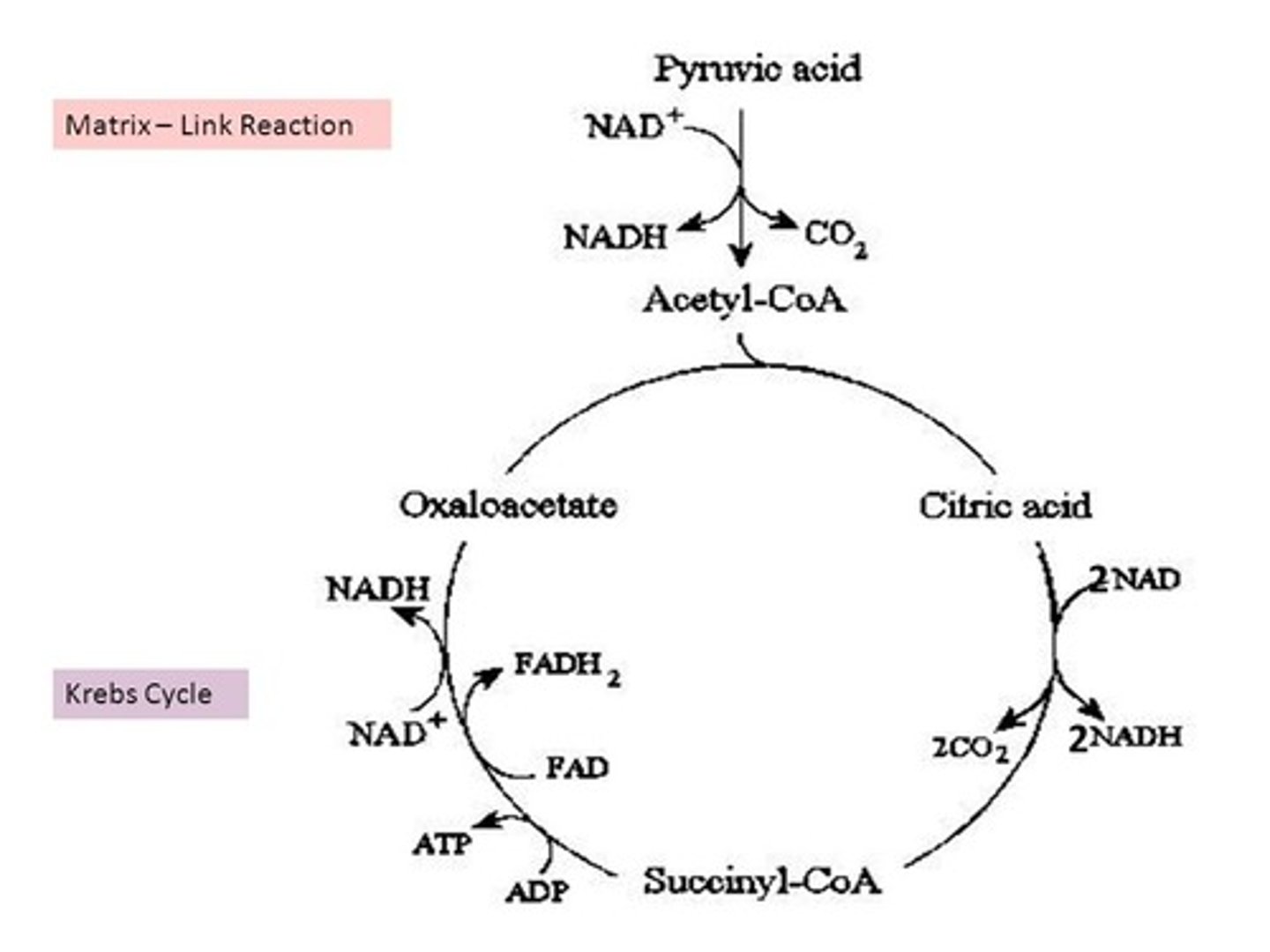
Draw or envision a mitochondria. Label the following: inner membrane, outer membrane, intermembrane space, matrix, and cristae.
Cristae are the folds of the inner membrane.
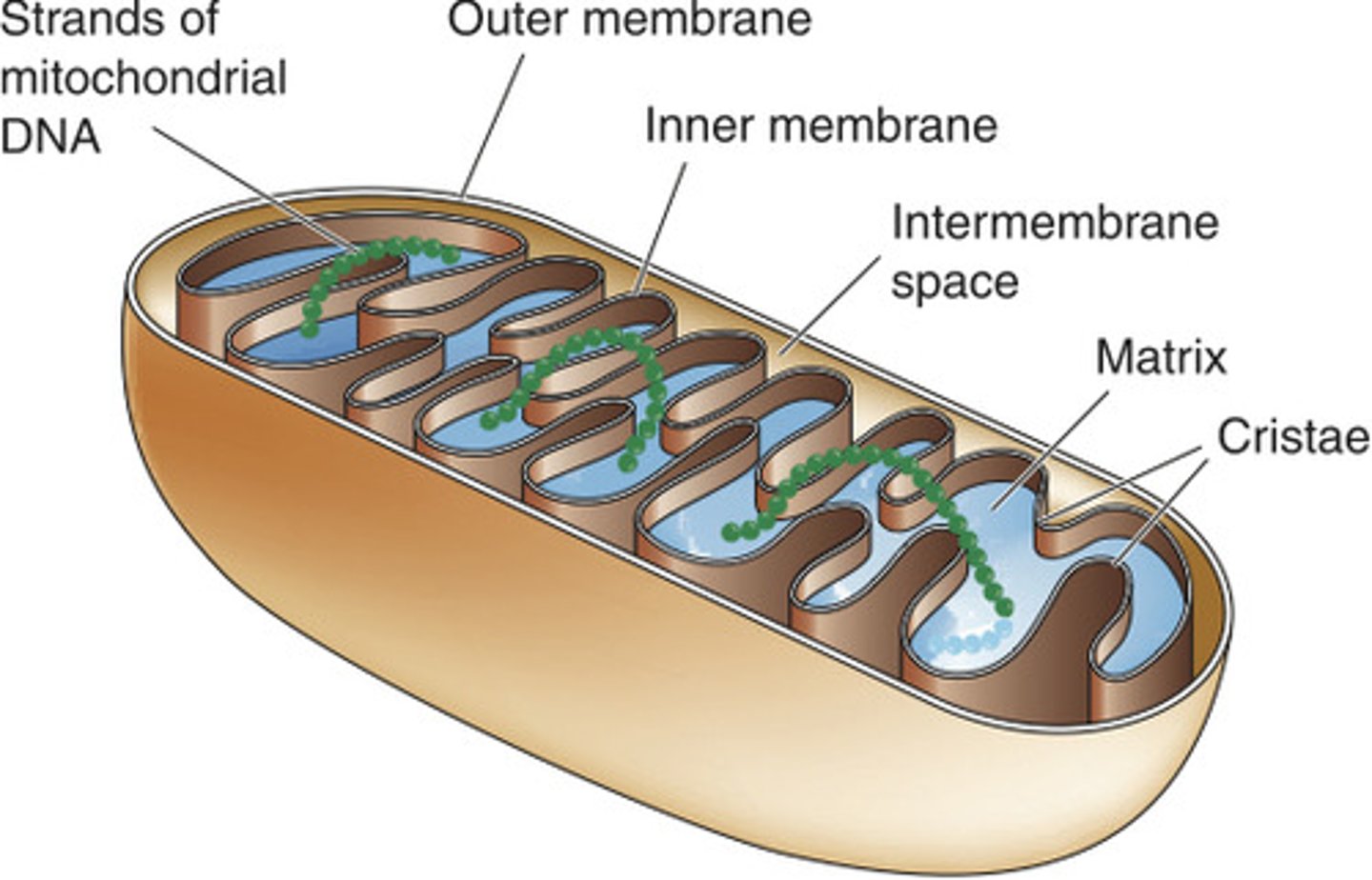
Where is the majority of the Kreb's cycle carried out in the mitochondria of eukaroytic cells?
(A) Outer Membrane
(B) Inner Membrane
(C) Intermembrane Space
(D) Mitochondrial Matrix
(D) Mitochondrial Matrix
The majority of the Kreb's cycle is carried out in the mitochondrial matrix of eukaroytic cells.
Struggling to memorize the metabolic pathways (such as glycolysis and beta-oxidation)? Learn them like the back of your hand using Andrew's Metabolic Pathways Mastery Course @ https://mcatselfprep.com/course/andrews-metabolic-pathways-mastery-course/
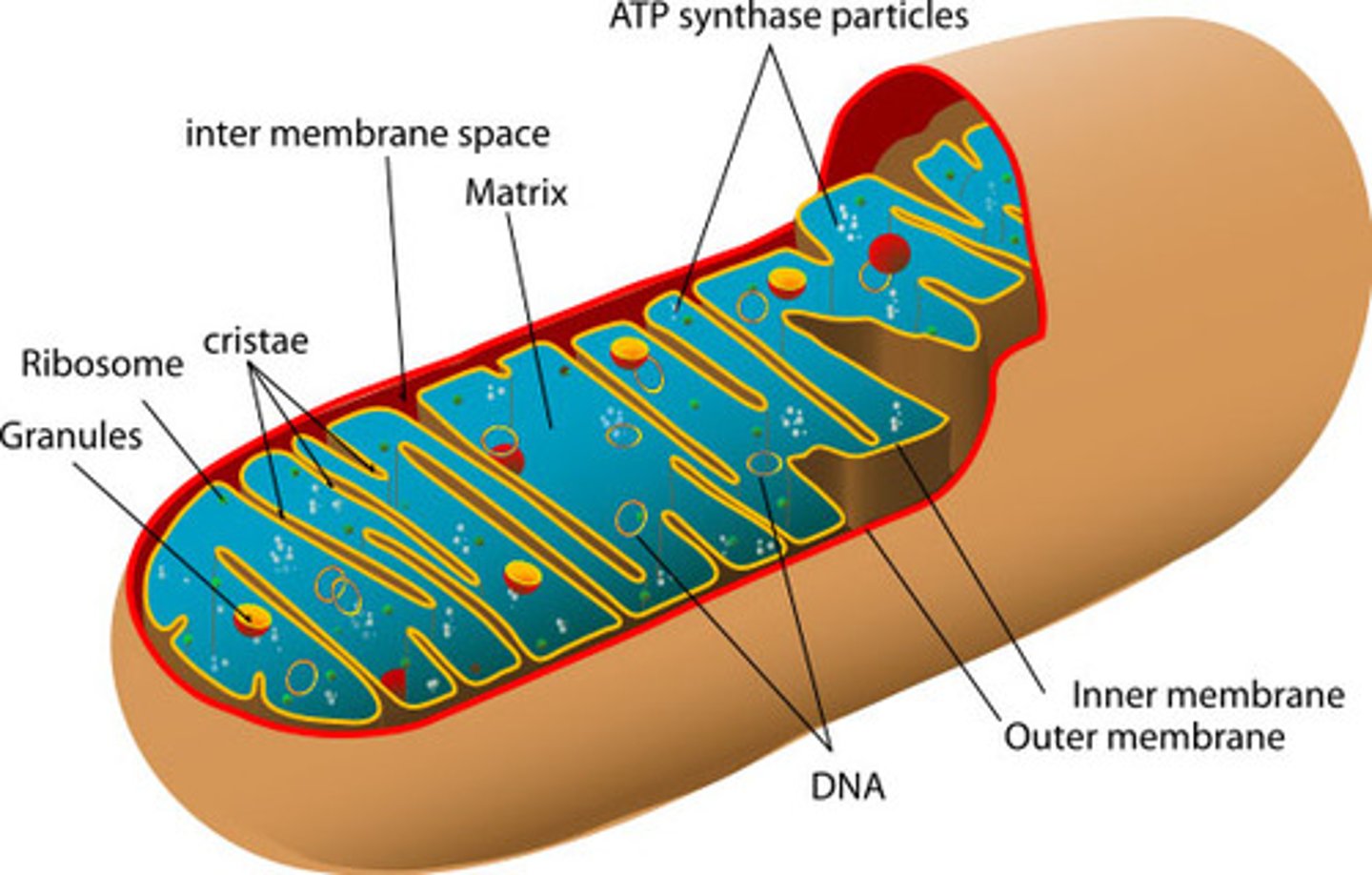
Draw out the Kreb's cycle, including all enzymes, substrates, and energy substrates.
It is absolutely necessary to be able to do this for the MCAT. And because it is so challenging to memorize all of this point blank, we've created our Metabolic Pathways Mastery Course: https://mcatselfprep.com/course/andrews-metabolic-pathways-mastery-course/
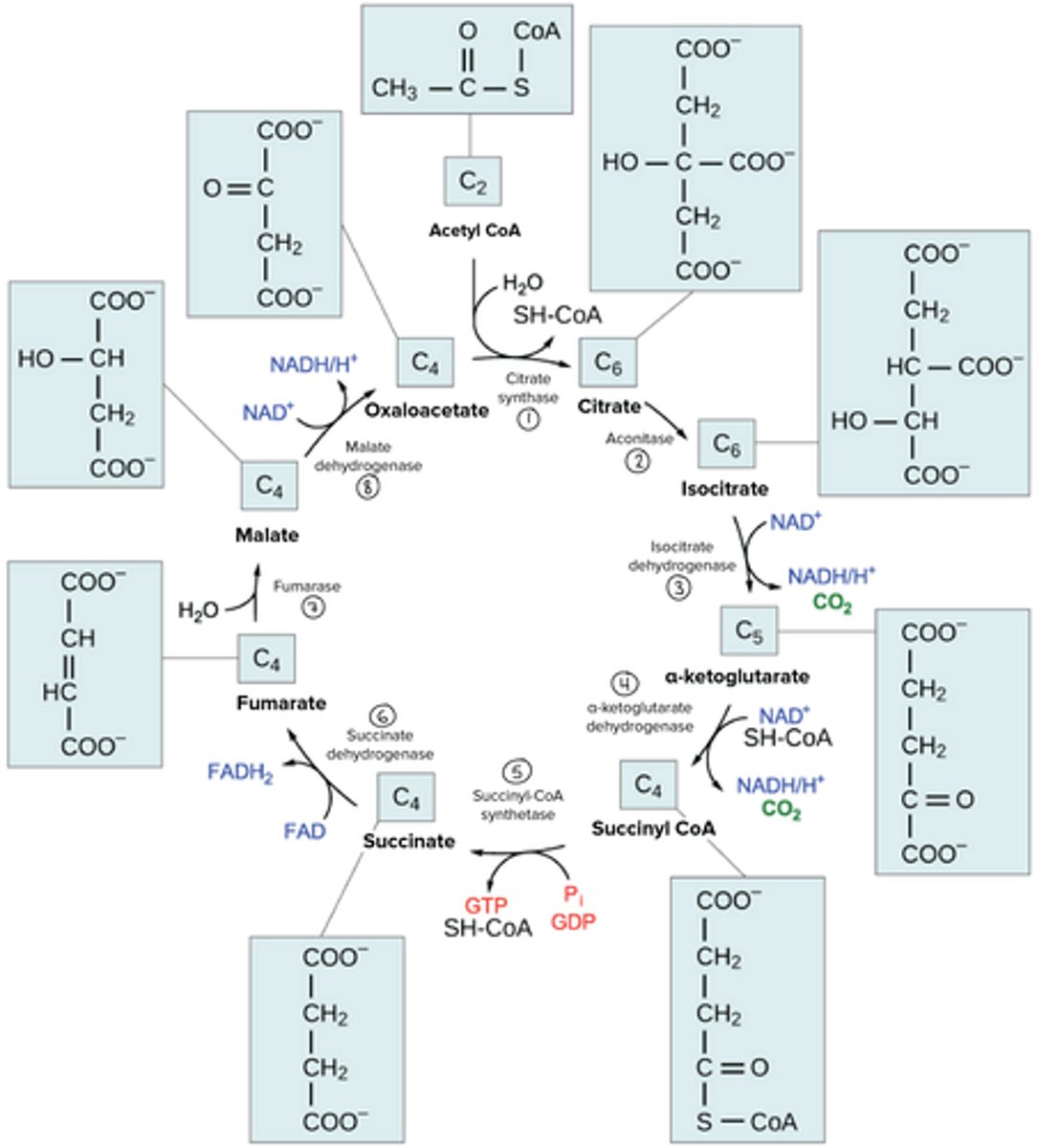
CRB True or false? Fumarate Dehydrogenase can be considered a Flavoprotein because it is covalently bound to FAD.
False. Succinate Dehydrogenase can be considered a Flavoprotein because it is covalently bound to FAD.
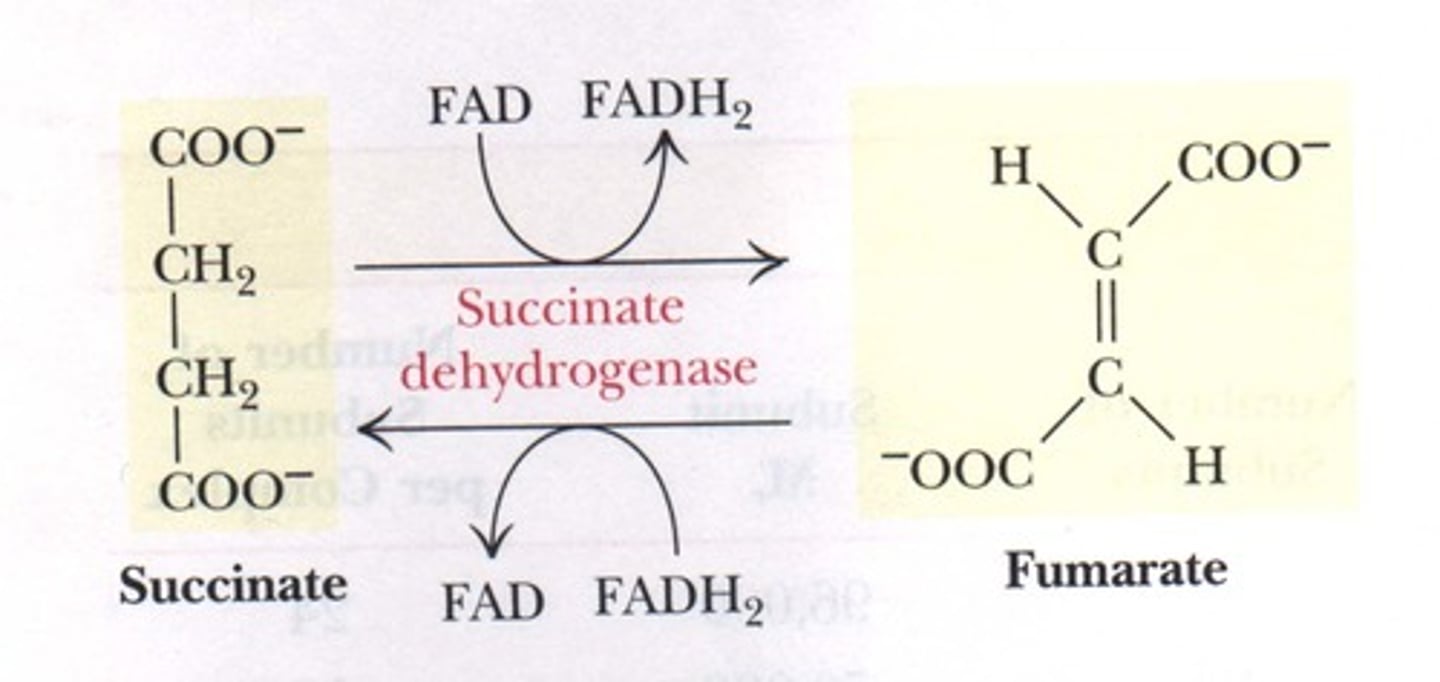
During the linking step (pyruvate dehydrogenase), pyruvate is _______________ and becomes ______________.
(A) oxidized, oxaloacetate
(B) oxidized, acetyl-CoA
(C) reduced, oxaloacetate
(D) reduced, acetyl-CoA
(B) oxidized, acetyl-CoA
During the linking step (pyruvate dehydrogenase), pyruvate is oxidized and becomes acetyl-CoA.
Struggling to memorize the metabolic pathways (such as glycolysis and beta-oxidation)? Learn them like the back of your hand using Andrew's Metabolic Pathways Mastery Course @ https://mcatselfprep.com/course/andrews-metabolic-pathways-mastery-course/

CRB True or false? The Decarboxylation of Pyruvate to Acetyl-CoA is irreversible, and this explains why Acetyl-CoA cannot directly form glucose.
True. The Decarboxylation of Pyruvate to Acetyl-CoA is irreversible, and this explains why Acetyl-CoA cannot directly form glucose.
Which of the following biomolecules can be converterted into acetyl-CoA?
I. Sugars
II. Fats
III. Proteins
(A) I Only
(B) I and II Only
(C) I and III Only
(D) I, II, and III
(D) I, II, and III
Sugars, proteins, and fats can all be interconverted into acetyl-CoA, which can then enter the Kreb's cycle and generate energy. Acetyl-CoA connects many of the metabolic pathways together, making it a very important intermediate.
Struggling to memorize the metabolic pathways (such as glycolysis and beta-oxidation)? Learn them like the back of your hand using Andrew's Metabolic Pathways Mastery Course @ https://mcatselfprep.com/course/andrews-metabolic-pathways-mastery-course/
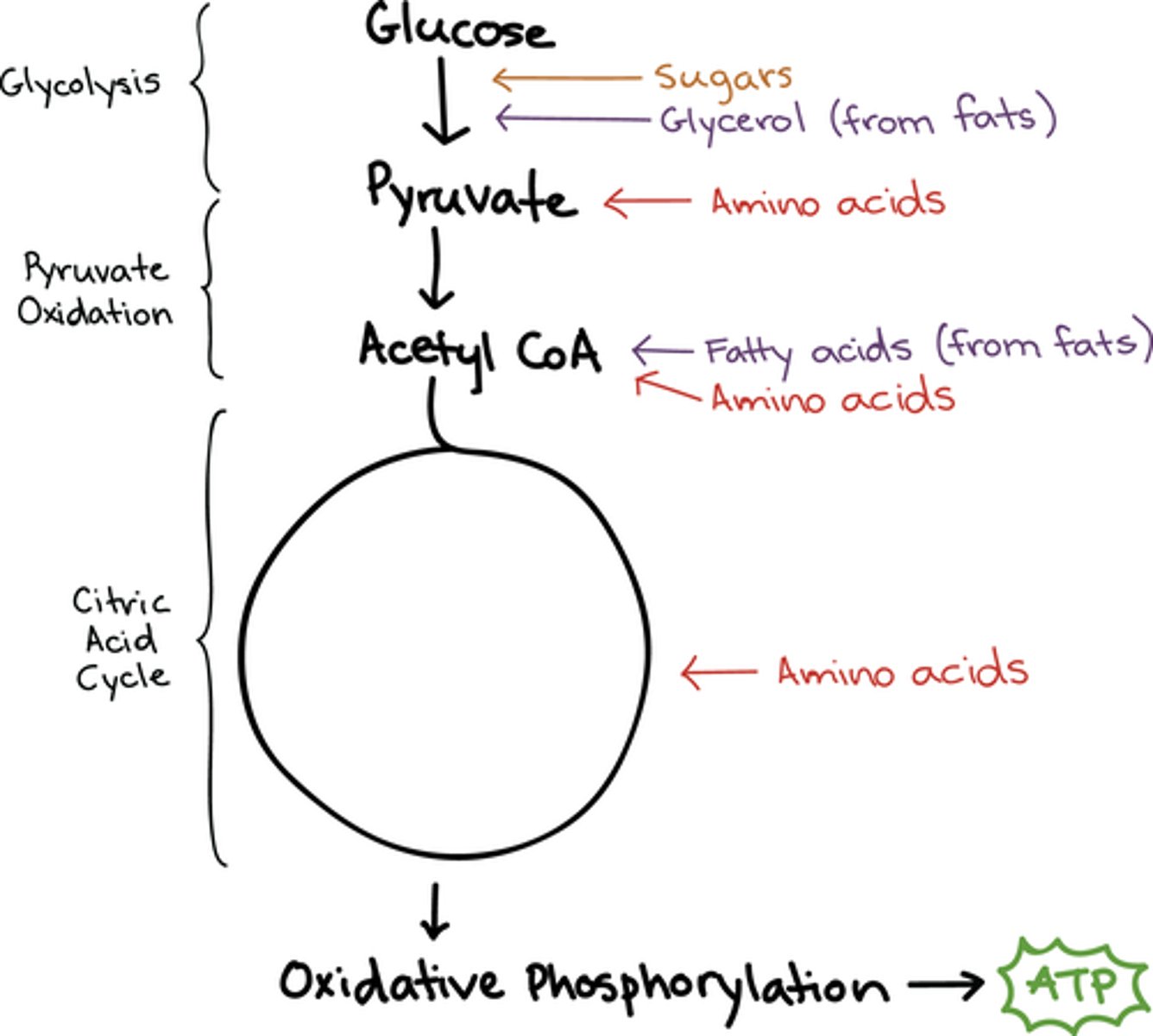
CRB Clearly, Acetyl-CoA can be formed in ways other than by Pyruvate Dehydrogenase. Which of the following is NOT a way Acetyl-CoA can be formed?
(A) Fatty Acid Oxidation
(B) Deamination of Nucleic Acids
(C) Amino Acid catabolism into Ketones
(D) Alcohol and Acetaldehyde Dehydrogenase
(B) Deamination of Nucleic Acids
Fatty Acid Oxidation, catabolizing Amino Acids into Ketones, and both Alcohol and Acetaldehyde Dehydrogenase can lead to Acetyl-CoA.
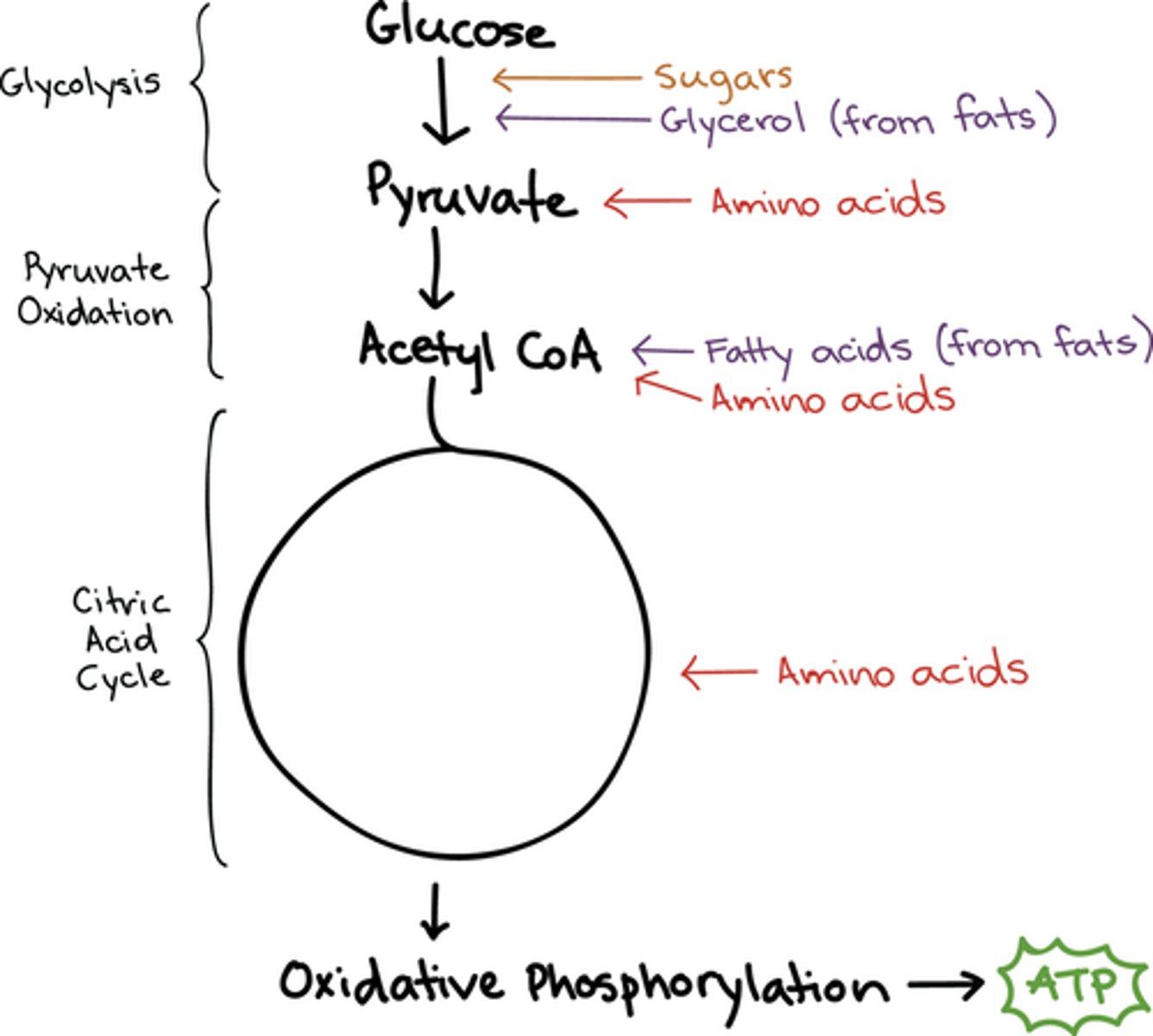
True or False. Fatty acids are a crucial during a state of hypoglycemia because they can be converted into glucose via gluconeogenesis.
False. Fatty acids can be converted into acetyl-CoA, and used to make ATP via the Kreb's Cycle and ETC, but acetyl-CoA cannot be converted back into pyruvate. For this reason, fatty acids are not able to contribute to gluconeogenesis.
Struggling to memorize the metabolic pathways (such as glycolysis and beta-oxidation)? Learn them like the back of your hand using Andrew's Metabolic Pathways Mastery Course @ https://mcatselfprep.com/course/andrews-metabolic-pathways-mastery-course/
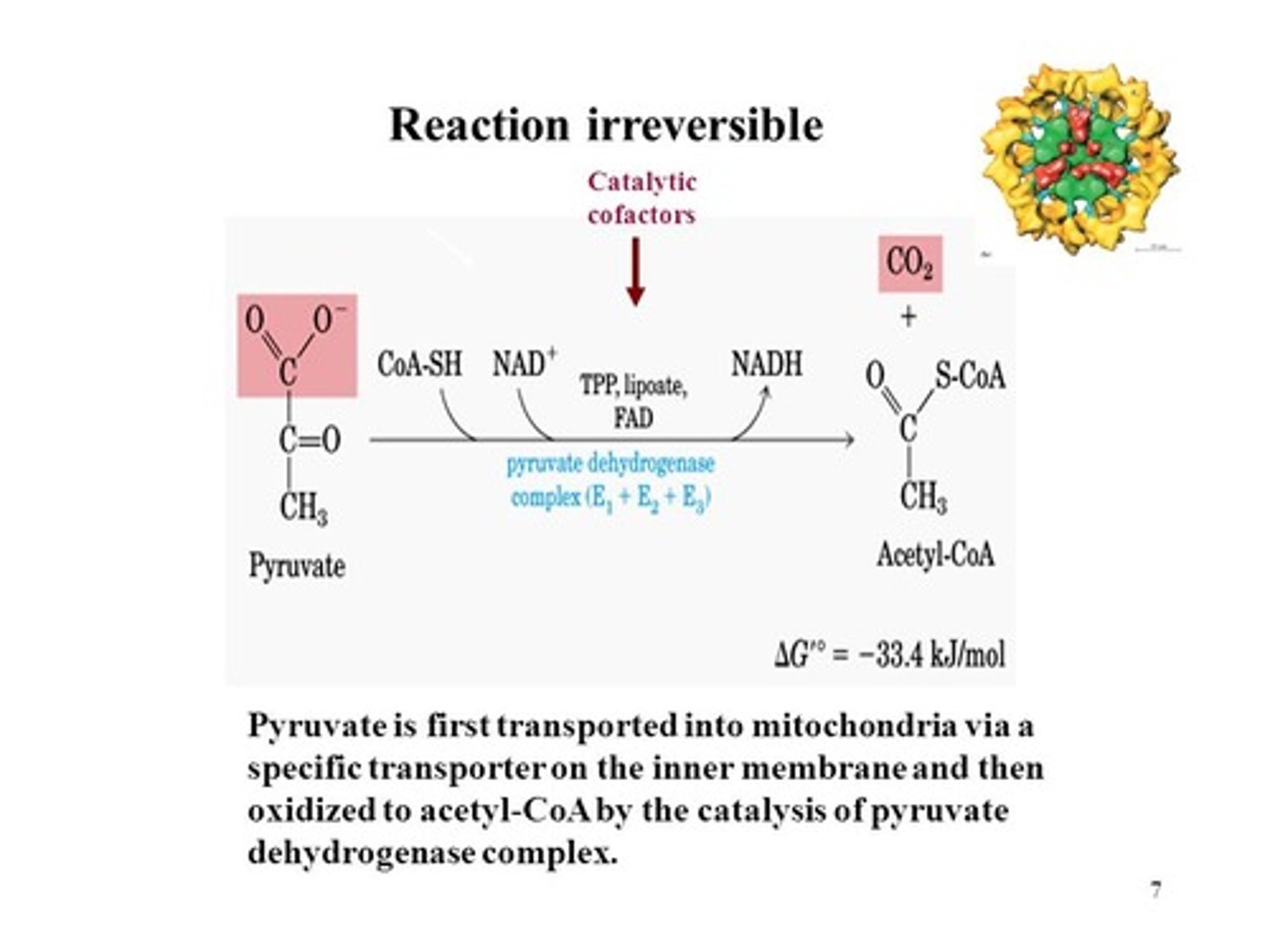
Draw out the pyruvate dehydrogenase reaction (the linking step), including all enyzmes, substrates, and energy substrates.
It is absolutely necessary to be able to do this for the MCAT. And because it is so challenging to memorize all of this point blank, we've created our Metabolic Pathways Mastery Course: https://mcatselfprep.com/course/andrews-metabolic-pathways-mastery-course/
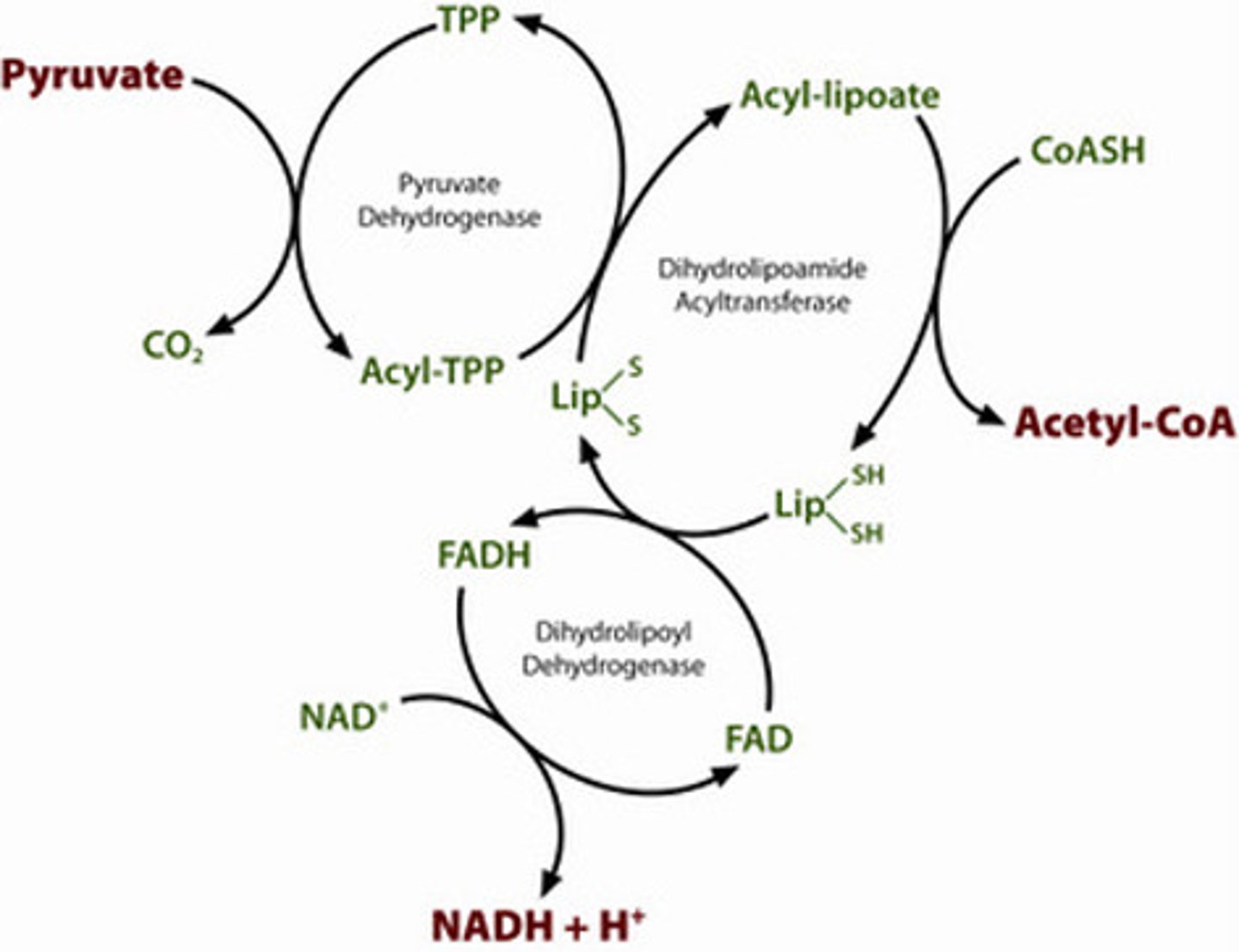
State whether each of the following molecules is an allosteric activator or inhibitor of pyruvate dehydrogenase:
- CoA
- NADH
- ATP
- NAD+
- Fatty Acids
- Pyruvate
- AMP
- Ca2+
- Acetyl-CoA
- CoA - Activator
- NADH - Inihibitor
- ATP - Inihibitor
- NAD+ - Activator
- Fatty Acids - Inihibitor
- Pyruvate - Activator
- AMP - Activator
- Ca2+ - Activator
- Acetyl-CoA - Inihibitor
Rule of thumb is to remember that typically a substrate will act as an activator and a product will act as an inhibitor.
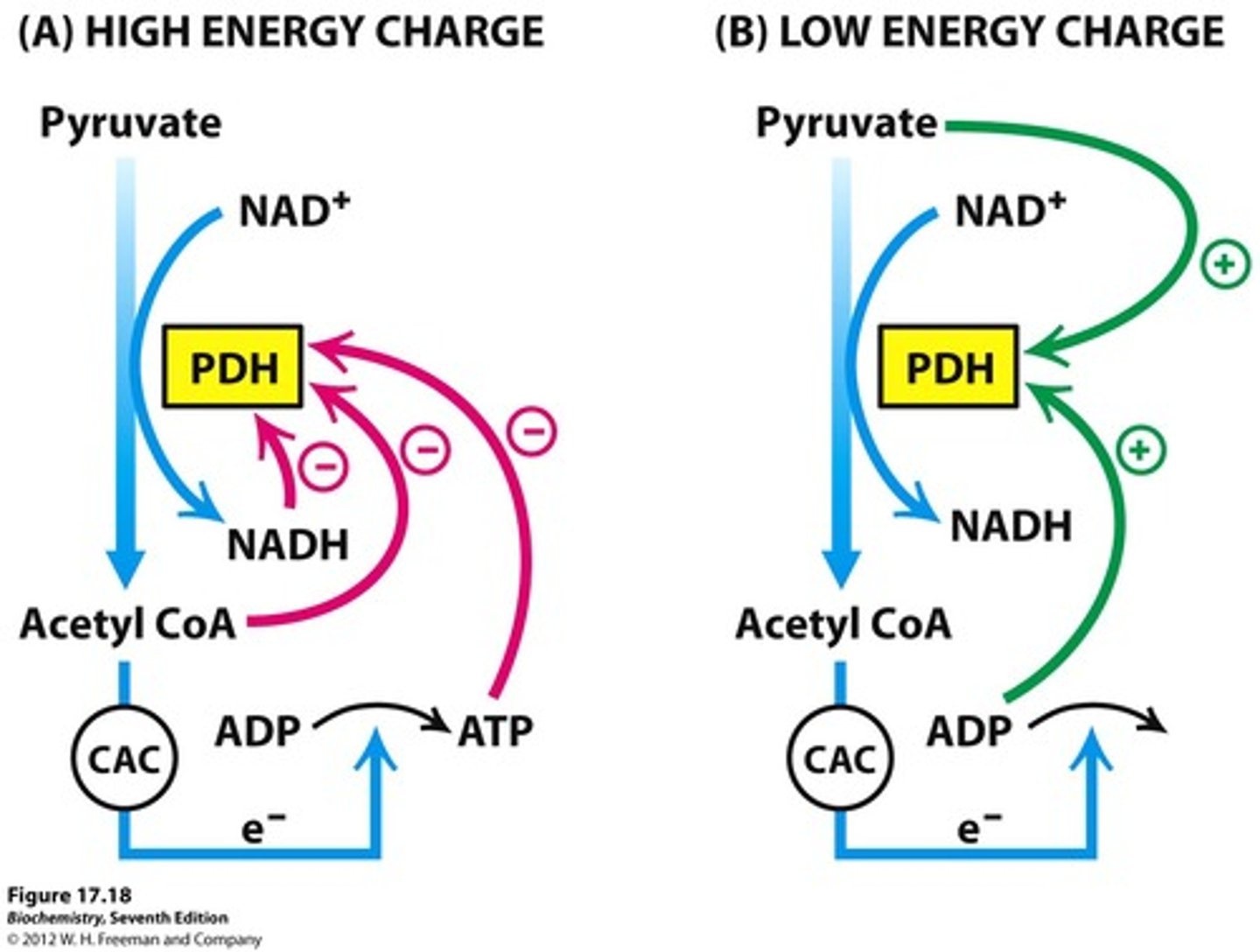
CRB Which of the following are pairs of cofactors used by Pyruvate Dehydrogenase?
I. CoA and Thiamine Pyrophosphate
II. Lipoic acid and FAD
III. NAD+ and NADP
(A) I only
(B) I and II only
(C) II and III only
(D) I, II and III
(B) I and II only
Each of the following are cofactors used by Pyruvate Dehydrogenase:
I. CoA and Thiamine Pyrophosphate
II. Lipoic acid and FAD
III. NAD+ only
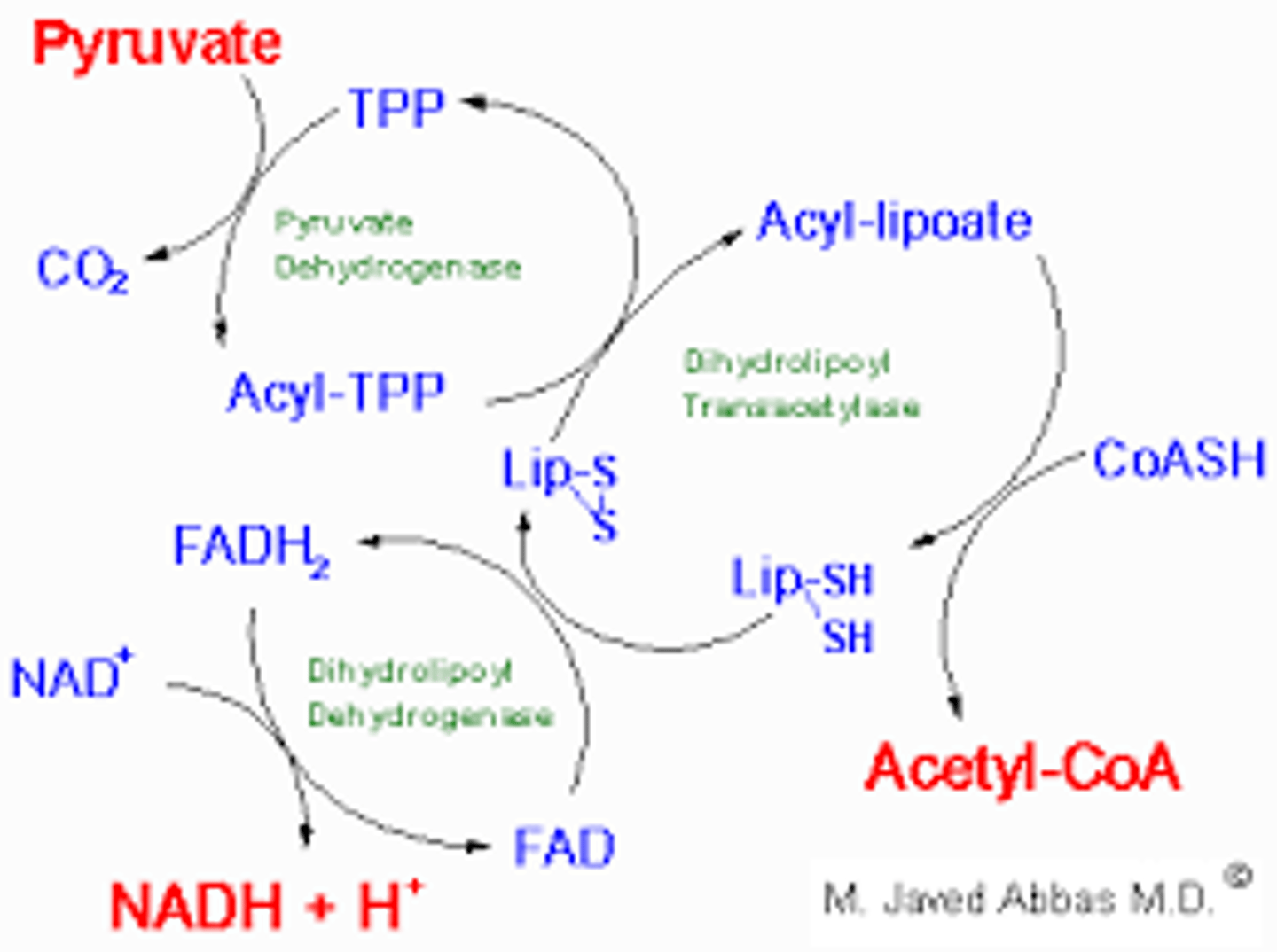
If ATP levels are high, why would it be in the cell's best interest to inhibit pyruvate dehydrogenase?
If ATP levels are high, that indicates that the cell already has enough energy; thus, it should slow down the production of that energy by inhibiting pyruvate dehydrogenase, which will in turn slow down the citric acid cycle since acetyl-CoA is required for it to run.

CRB If Acetyl-CoA levels are high, why would it be in the cell's best interest to inhibit Pyruvate Dehydrogenase? Where will the Acetyl-CoA be used?
If Acetyl-CoA levels are high, this means that the Krebs Cycle has slowed down (probably due to reduced Oxygen levels), and the Acetyl-CoA could not actually be used to produce ATP.
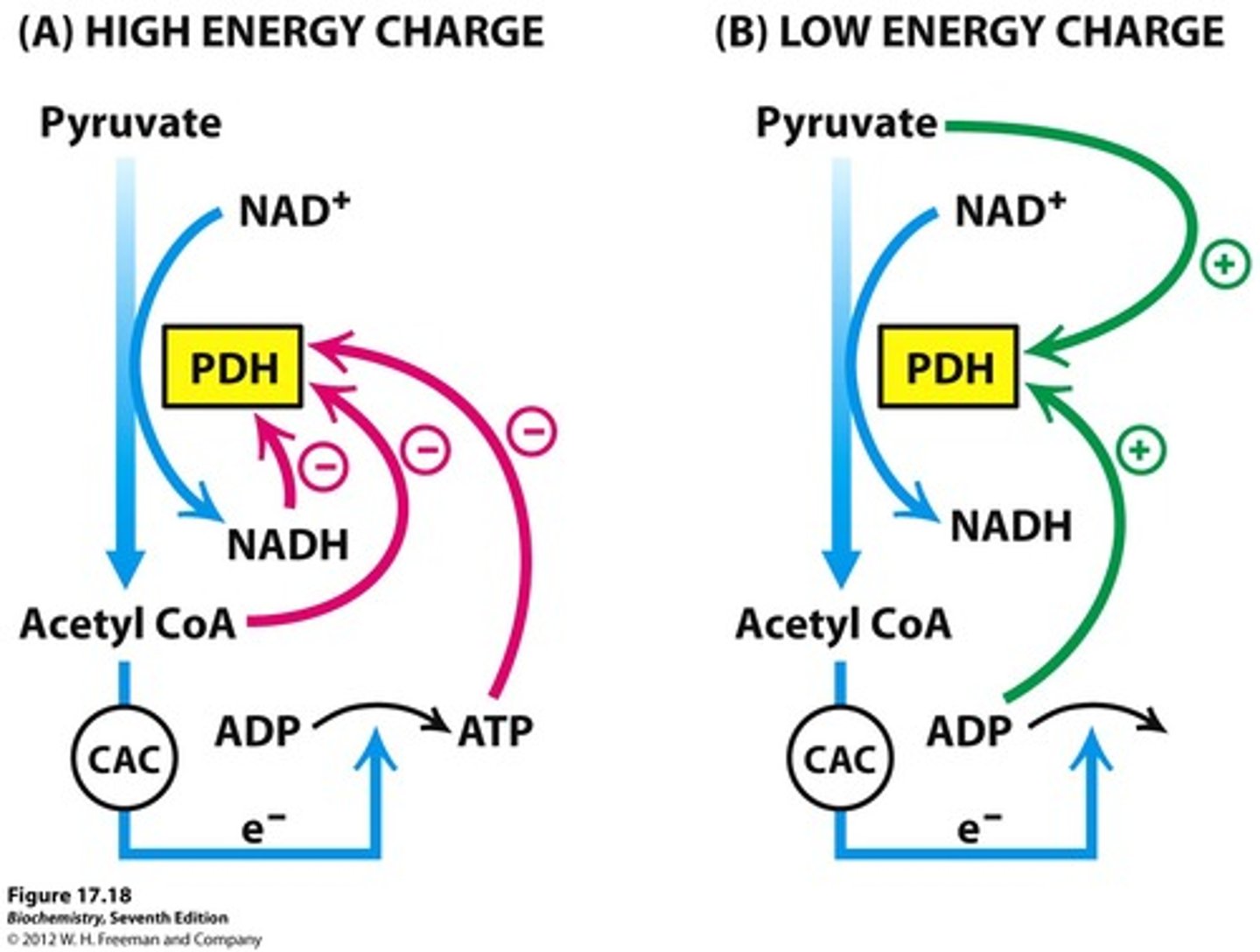
CRB Which of the following molecules would Pyruvate be directly converted to in order to enter Gluconeogenesis?
(A) Glycerol
(B) Citrate
(C) Acetyl CoA
(D) Oxaloacetate
(D) Oxaloacetate
Pyruvate is converted to Oxaloacetate to enter Gluconeogenesis.
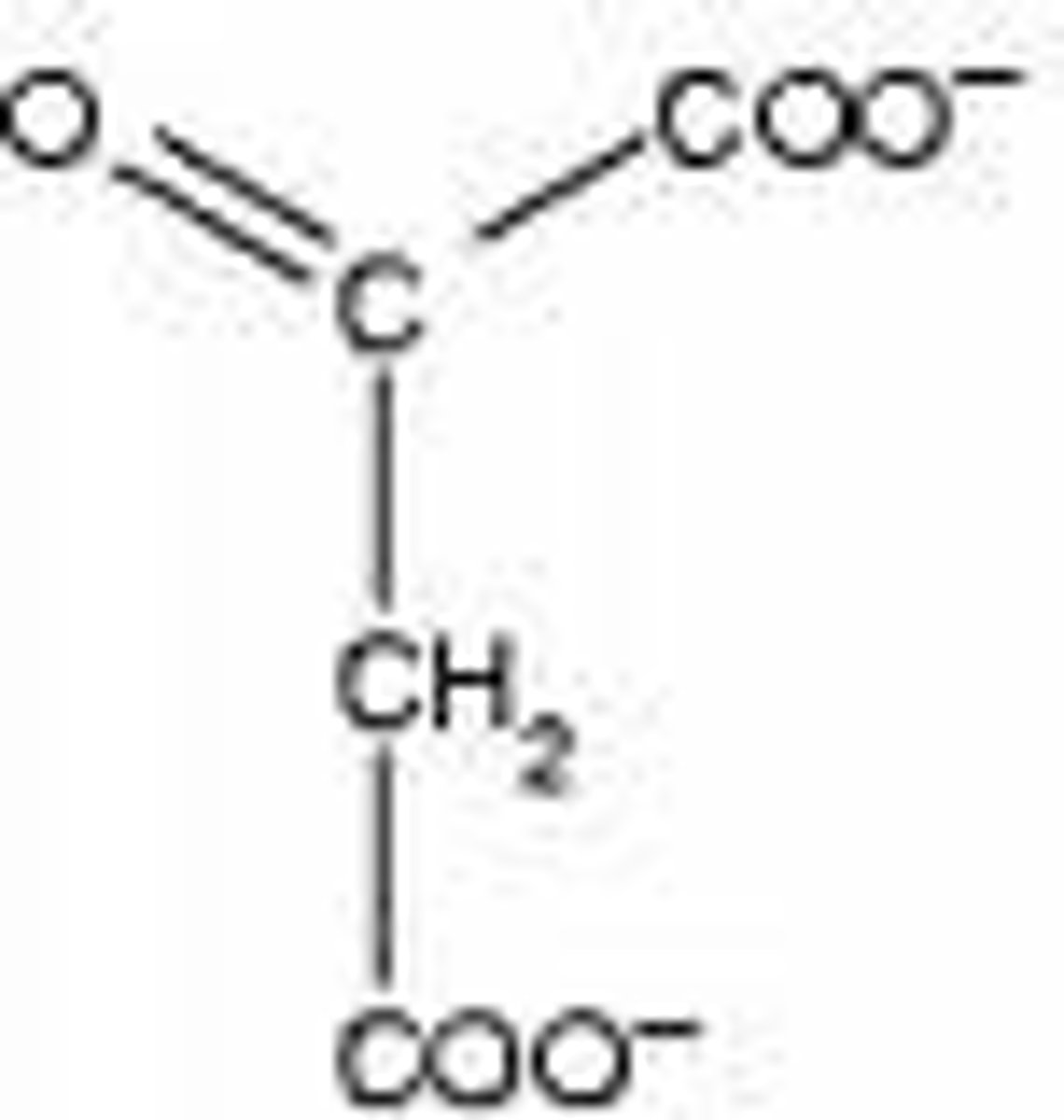
If fatty acid levels are high, why would it be in the cell's best interest to inhibit pyruvate dehydrogenase?
The pyruvate dehydrogenase reaction produces acetyl-CoA which is used to build up fatty acids. If there is already a high level of fatty acids, the cell will try and decrease the level of acetyl-CoA by inhibiting pyruvate dehydrogenase.
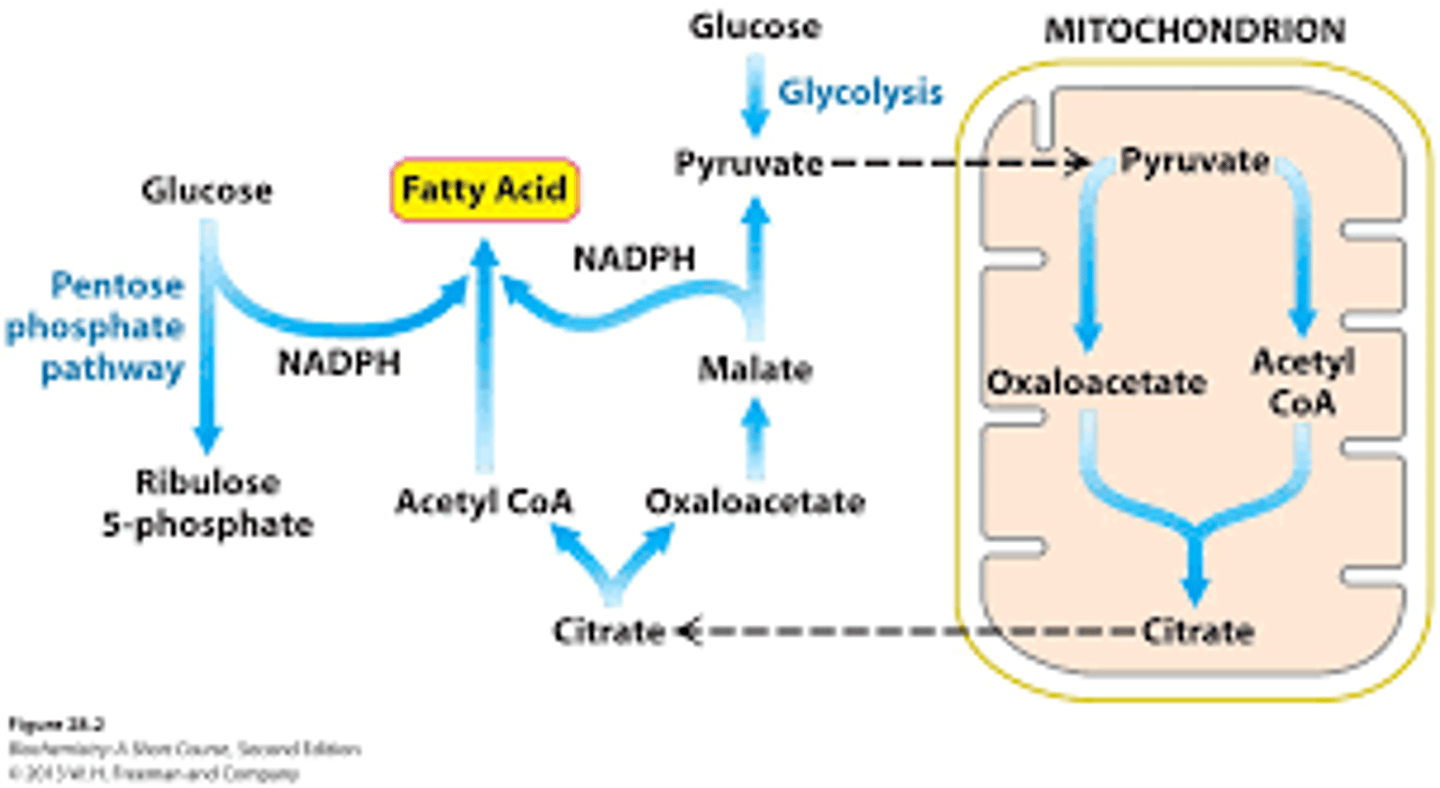
If calcium levels are high, why would it be in the cell's best interest to activate pyruvate dehydrogenase?
High levels of calcium result from muscle contraction, which is a process that requires energy. To get more energy, the cell will want to ramp up the linking step and the Kreb's cycle by activating pyruvate dehydrogenase.
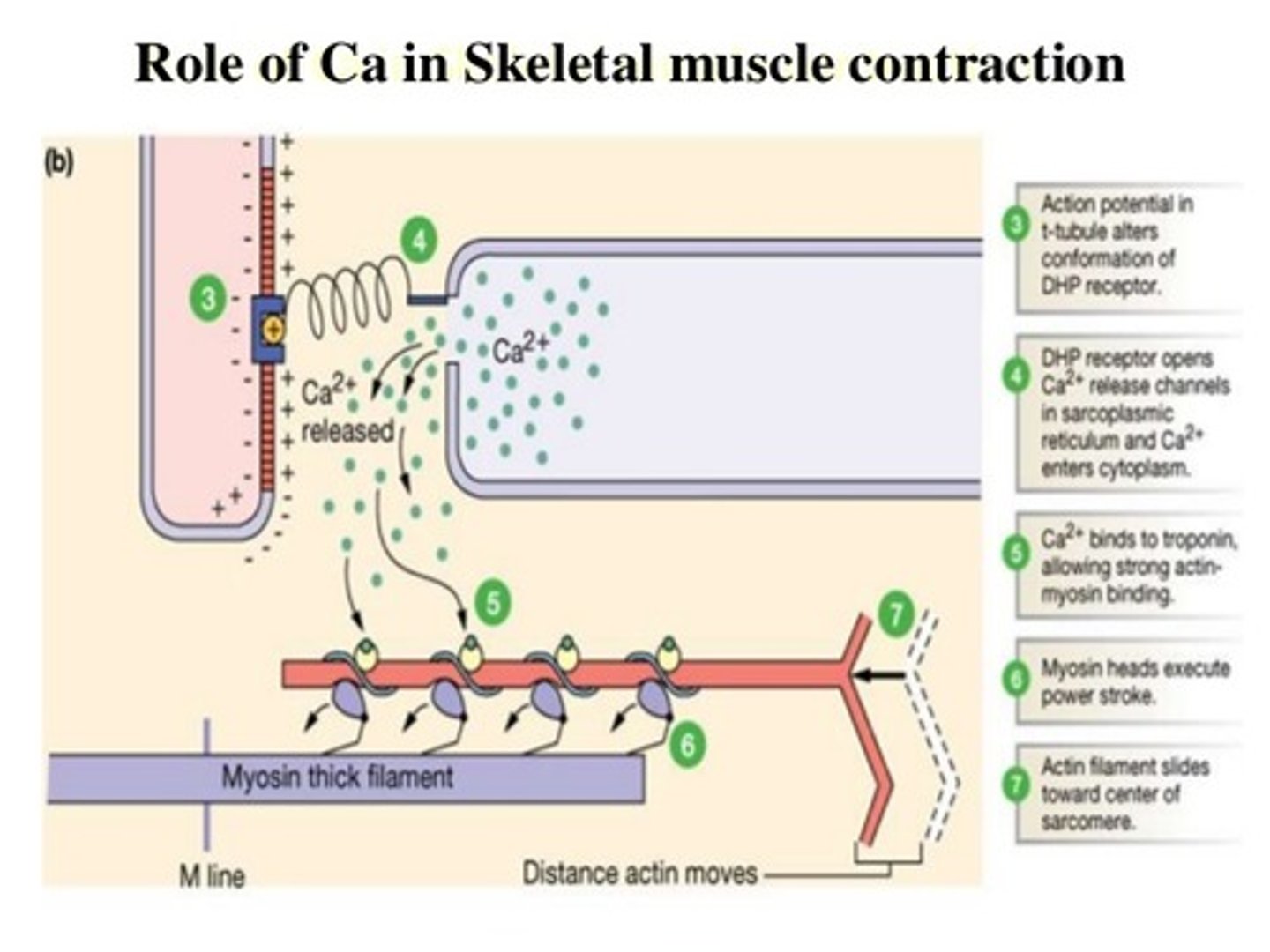
Why is it that the Kreb's cycle is not regulated via hormones?
The Kreb's cycle is not regulated via hormones because the Kreb's cycle will always be turned on whether an individual is in the fed or fasted state.
Why is it that glycolysis can be completely turned off while Kreb's cycle is usually turned on to one degree or another?
Glycolysis is only needed when you are using glucose for energy. The Kreb's cycle on the other hand is needed for the utilization of sugars, fats, or amino acids for energy. Because cells need energy basically all the time, they will at least want the Kreb's cycle turned on to some degree or another.
Hormonal Regulation is focused on meeting the energy needs of the ______________. Allosteric regulation substrate availability are focused on meeting the energy needs of the _______________.
(A) organism, muscles
(B) organism, cell
(C) cell, organism
(D) cell, muscles
(B) organism, cell
Hormonal Regulation is focused on meeting the energy needs of the organism. Allosteric regulation substrate availability are focused on meeting the energy needs of the cell.
What will happen to the activity of the citric acid cycle when citrate is shuttled out of the mitochondrial matrix in an effort to carry acetyl-CoA to the site for fatty acid synthesis?
The citric acid cycle will slow down since the substrates of acetyl-CoA and citrate are not as available anymore.
Struggling to memorize the metabolic pathways (such as glycolysis and beta-oxidation)? Learn them like the back of your hand using Andrew's Metabolic Pathways Mastery Course @ https://mcatselfprep.com/course/andrews-metabolic-pathways-mastery-course/

CRB True or false? There is no universal number of ATP produced by Oxidative Metabolism because there are different shuttling techniques used to transport NADH from Glycolysis to the Mitochondria in different cell types.
True. There is no universal number of ATP produced by Oxidative Metabolism because there are different shuttling techniques used to transport NADH from Glycolysis to the Mitochondria in different cell types.

What will happen to the activity of the citric acid cycle when amino acids are being broken down into alpha-ketoglutarate?
The citric acid cycle will speed up since the alpha-ketoglutarate, a key substrate for the citric acid cycle, is now more available.
Struggling to memorize the metabolic pathways (such as glycolysis and beta-oxidation)? Learn them like the back of your hand using Andrew's Metabolic Pathways Mastery Course @ https://mcatselfprep.com/course/andrews-metabolic-pathways-mastery-course/
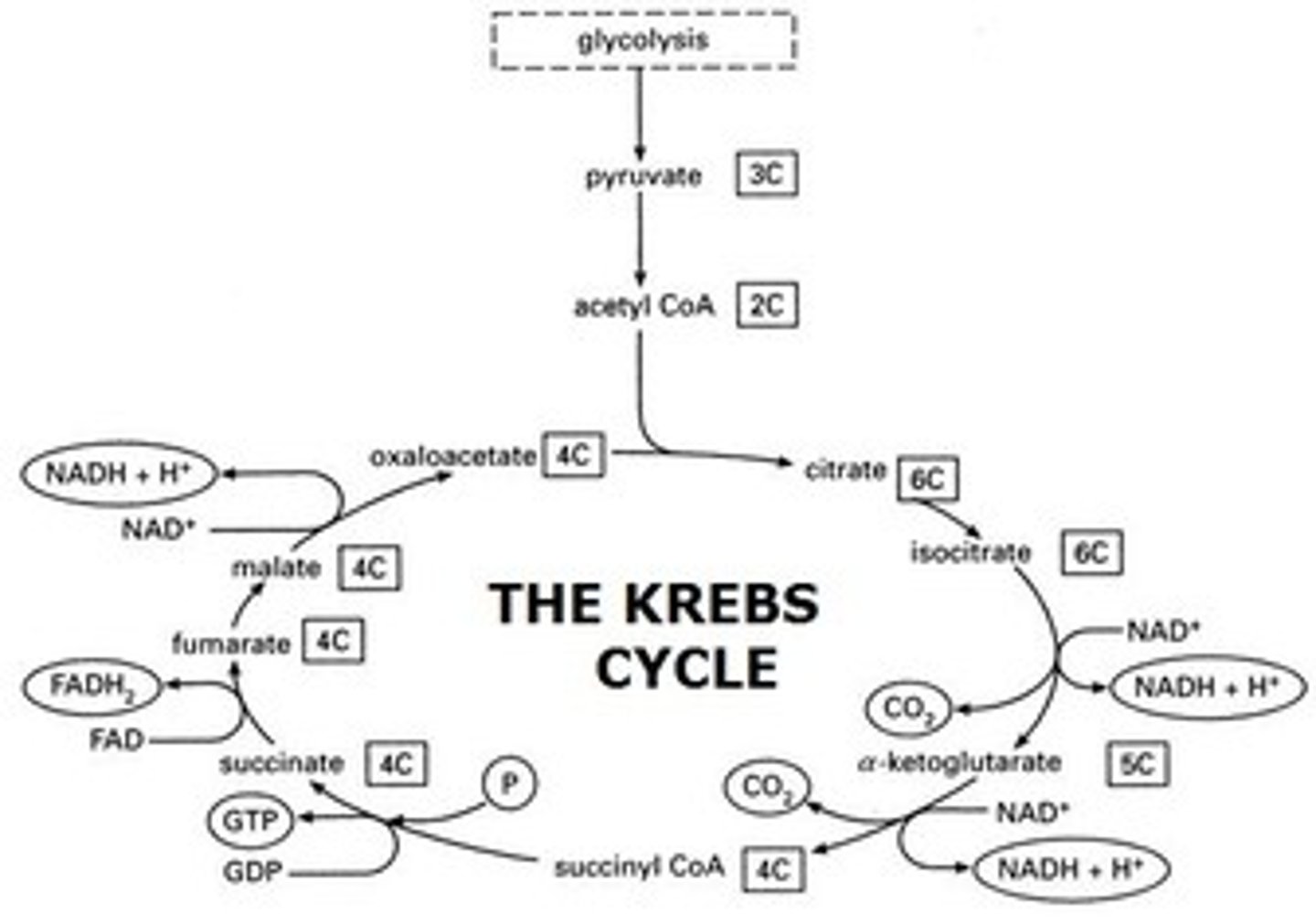
CRB Which of the following statements about forming Citrate are true?
I. The Thioester bond in Acetyl-CoA is hydrolyzed, providing the energy to drive Citrate Synthesis.
II. The two carbons from the Acetyl-CoA are incorporated into Citrate's 5 Carbons.
III. The two carbons Citrate acquired from Acetyl-CoA will leave the TCA cycle as Carbon Dioxide.
(A) I only
(B) I and III only
(C) II and III only
(D) I, II and III
(B) I and III only
Each of the following statements about Citrate are true:
I. The Thioester bond in Acetyl-CoA is hydrolyzed, providing the energy to drive Citrate Synthesis.
II. The two carbons from the Acetyl-CoA are incorporated into Citrate's 6 Carbons.
III. The two carbons Citrate acquired from Acetyl-CoA will leave the TCA cycle as Carbon Dioxide.
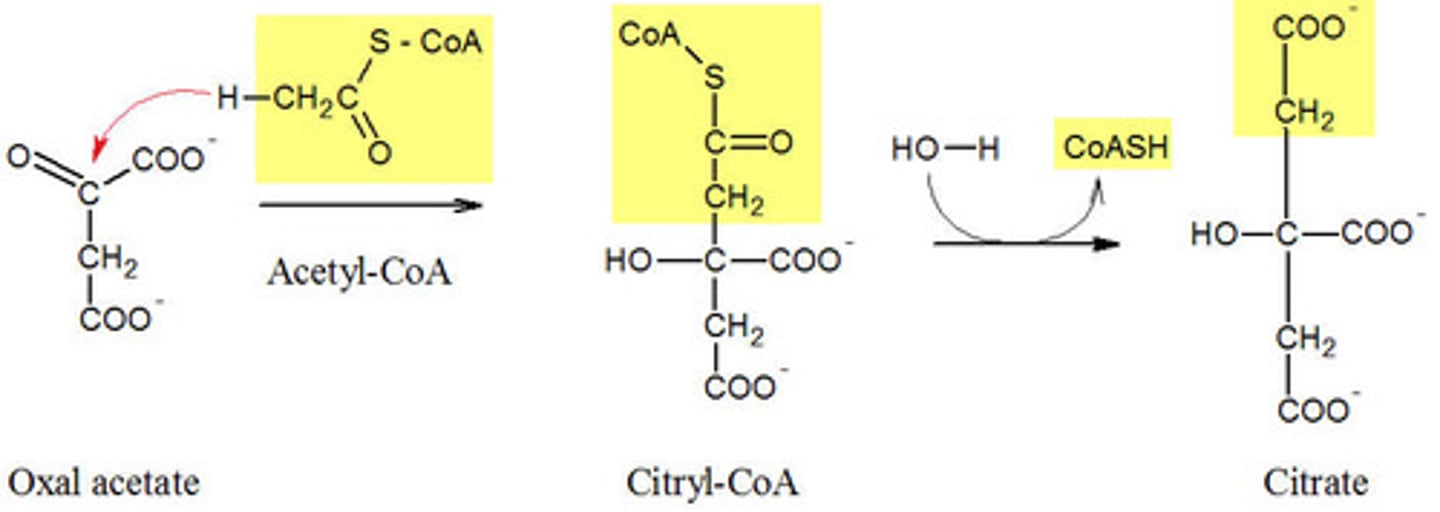
Which three enzymes of the citric acid cycle are the primary site for allosteric regulation of the citric acid cycle?
Citrate synthase, isocitrate dehydrogenase, and alpha-ketoglutarate dehydrogenase are allosterically regulated, controlling the citric acid cycle.
Struggling to memorize the metabolic pathways (such as glycolysis and beta-oxidation)? Learn them like the back of your hand using Andrew's Metabolic Pathways Mastery Course @ https://mcatselfprep.com/course/andrews-metabolic-pathways-mastery-course/
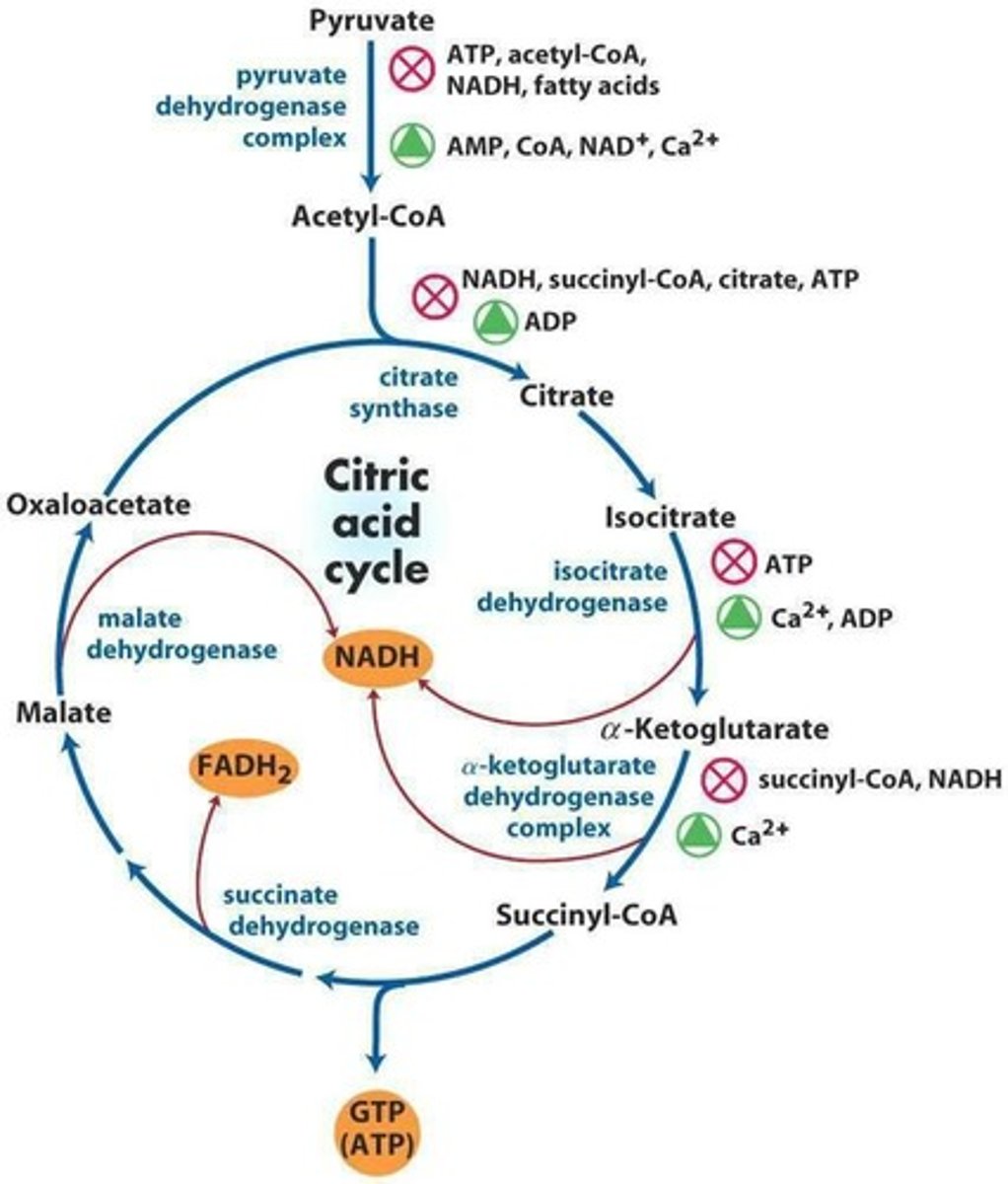
Which of the following are allosterically inhibited by NADH? ATP? Citrate? Succinyl-CoA?
(1) Citrate synthase
(2) Isocitrate dehydrogenase
(3) Alpha-ketoglutarate dehydrogenase
(1) Citrate synthase - NADH, ATP, Citrate, and Succinyl-CoA (all of them because it is the starting point for the citric acid cycle)
(2) Isocitrate dehydrogenase - NADH and ATP.
(3) Alpha-ketoglutarate dehydrogenase - NADH and succinyl-CoA
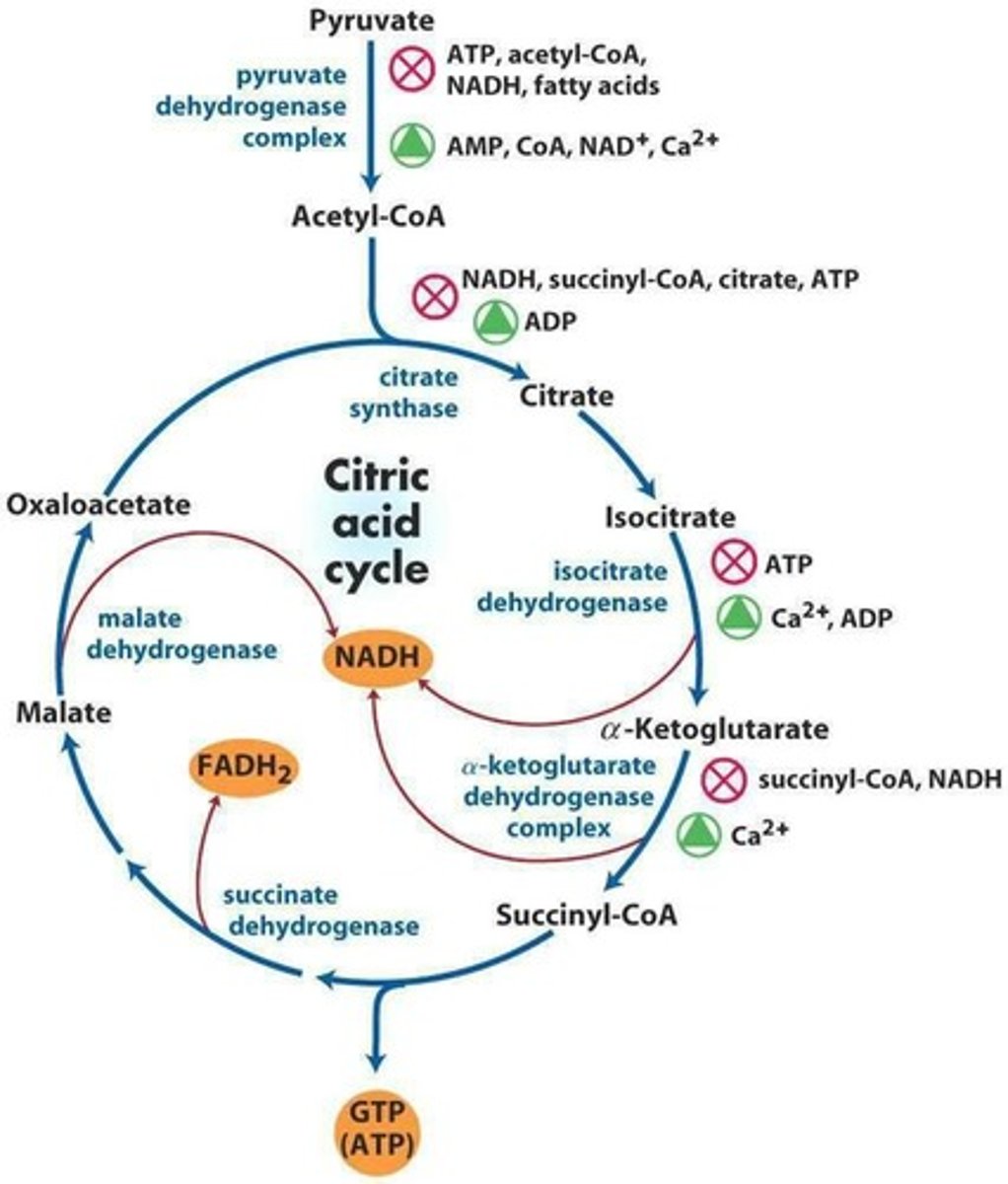
Which of the following are allosterically activated by ADP? Ca2+? Both?
(1) Citrate synthase
(2) Isocitrate dehydrogenase
(3) Alpha-ketoglutarate dehydrogenase
(1) Citrate synthase - ADP
(2) Isocitrate dehydrogenase - ADP and Ca2+
(3) Alpha-ketoglutarate dehydrogenase - Ca2+
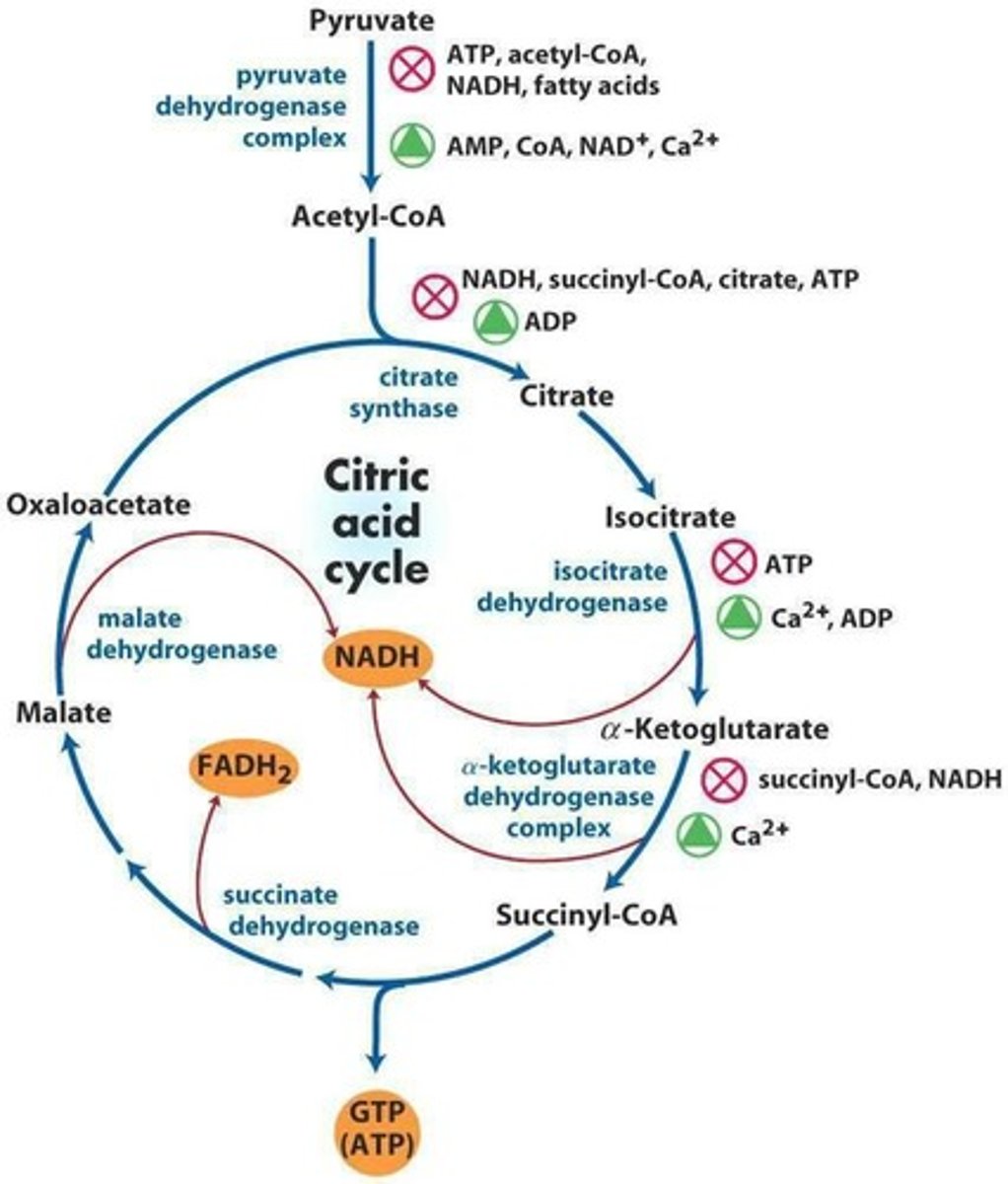
CRB Compare Synthases and Synthetases.
Synthases and Synthetases both catalyze synthesis reactions.
Synthases do not require outside energy to catalyze their reactions, whereas Synthetases do need outside energy to catalyze their reactions (usually in the form of GTP or ATP).

CRB True or false? Dehydrogenase enzymes in the various biochemical pathways are Lyase enzymes.
False. Dehydrogenase enzymes in the various biochemical pathways are Oxidoreductase enzymes.
During the electron transport chain, NADH is oxidized to NAD+, resulting in the formation of electrons. Those electrons are then used to convert O2 into:
(A) CO2
(B) ROS
(C) H2O
(D) CO
(C) H2O
O2 is reduced into H2O via the following reaction during the electron transport chain:
2e- + 2H+ + 1/2O2 --> H2O
Struggling to memorize the metabolic pathways (such as glycolysis and beta-oxidation)? Learn them like the back of your hand using Andrew's Metabolic Pathways Mastery Course @ https://mcatselfprep.com/course/andrews-metabolic-pathways-mastery-course/
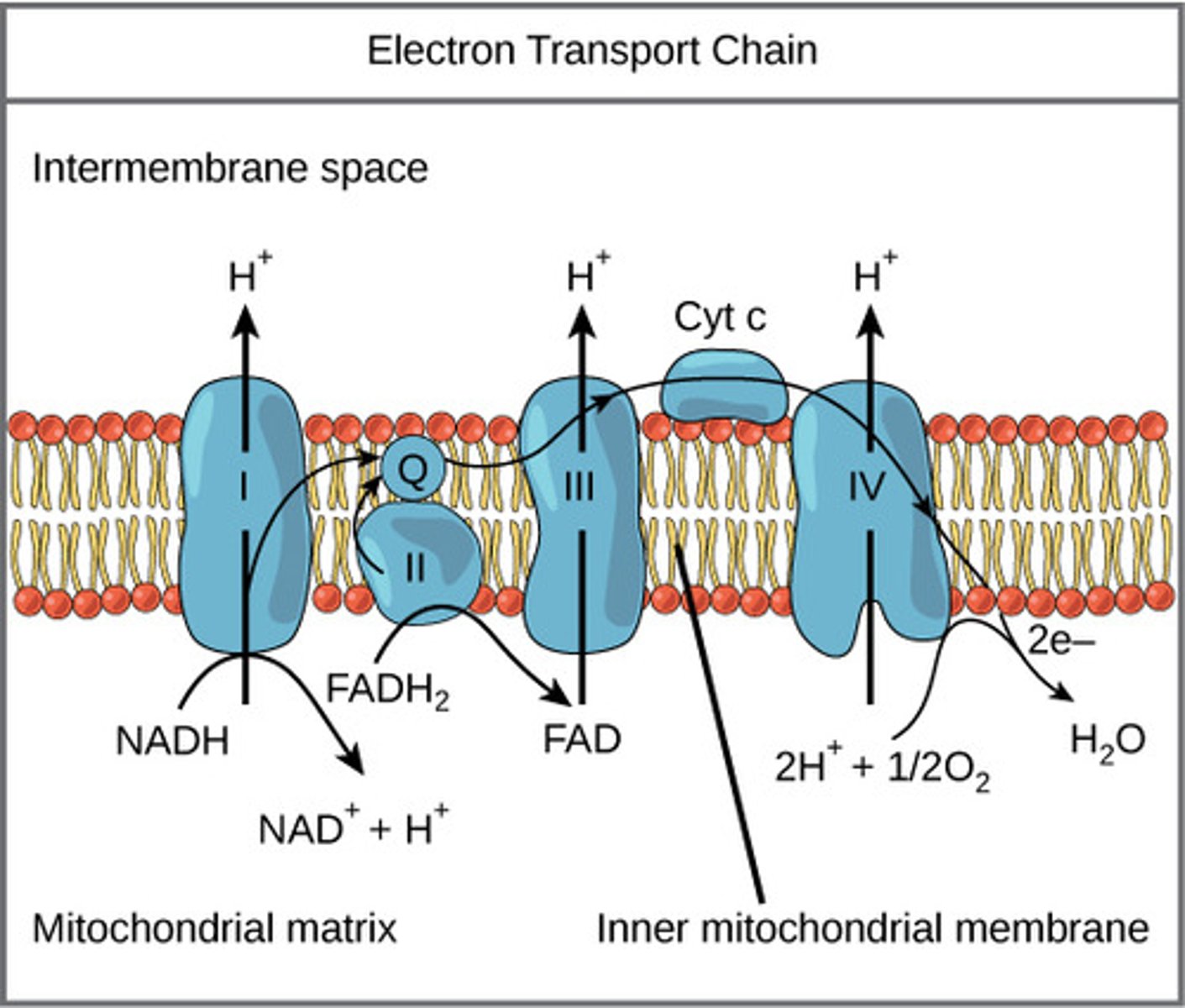
Where is the electron transport chain located?
(A) Mitochondrial Matrix
(B) Intermembrane Space
(C) Outer Mitochondrial Membrane
(D) Inner Mitochondrial Membrane
(D) Inner Mitochondrial Membrane
The electron transport chain is located within the inner mitochondrial membrane.

What is the role of the electron transport chain enzymes (complex I, II, III, and IV) embedded in the inner mitochondrial membrane?
The enzymes assist in the oxidation/reduction of electron carrier molecules, which in turn pumps H+ ions from the mitochondrial matrix into the intermembrane space.
Struggling to memorize the metabolic pathways (such as glycolysis and beta-oxidation)? Learn them like the back of your hand using Andrew's Metabolic Pathways Mastery Course @ https://mcatselfprep.com/course/andrews-metabolic-pathways-mastery-course/
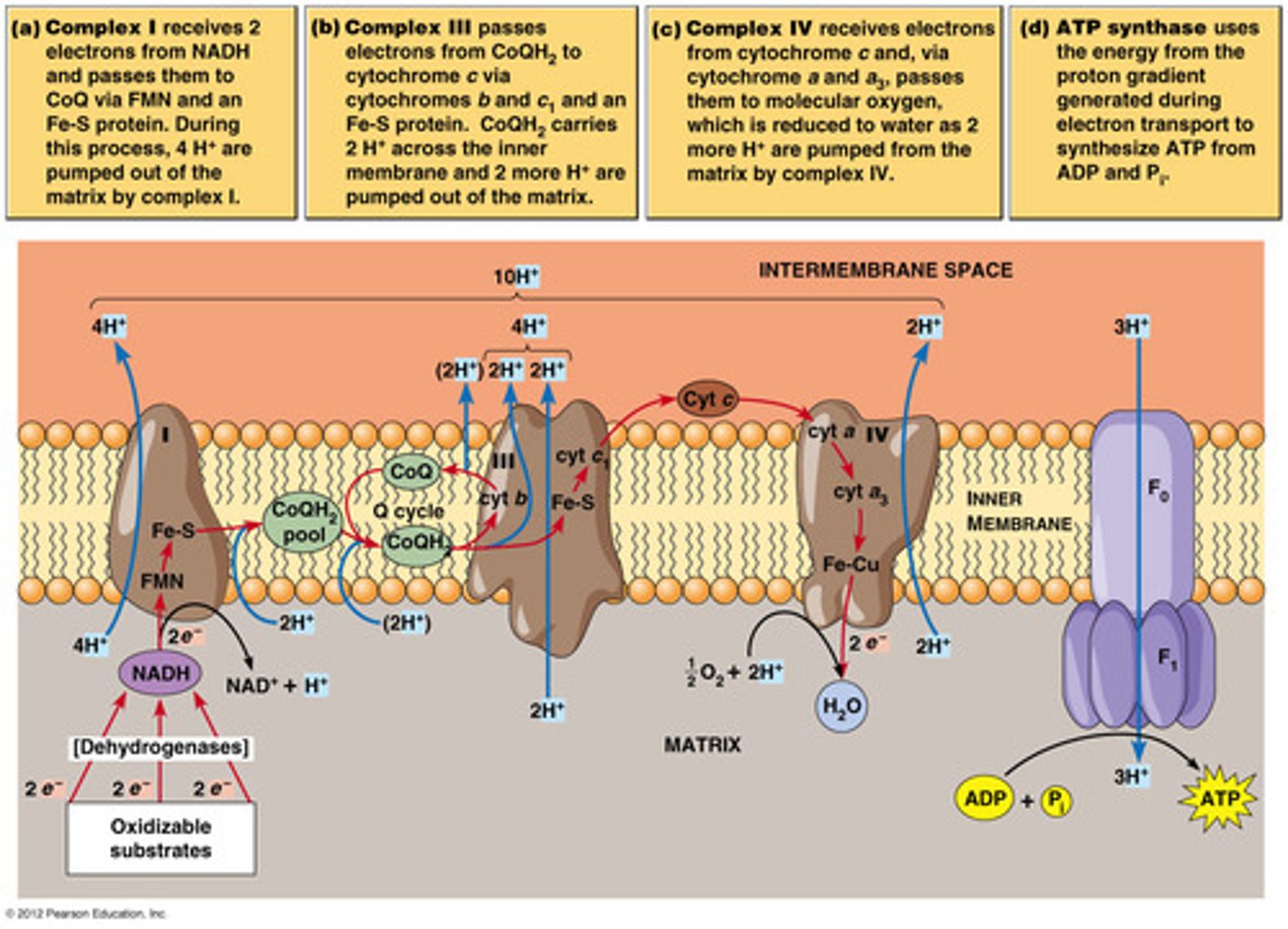
CRB Which of the following are pathways that electrons could follow in the Electron Transport Chain?
I. Complexes I > II > III > IV
II. Complexes I > III > IV
III. Complexes II > III > IV
(A) I only
(B) I and II only
(C) II and III only
(D) I, II and III
(C) II and III only
Each of the following are pathways that electrons could follow in the Electron Transport Chain:
II. Complexes I > III > IV
III. Complexes II > III > IV
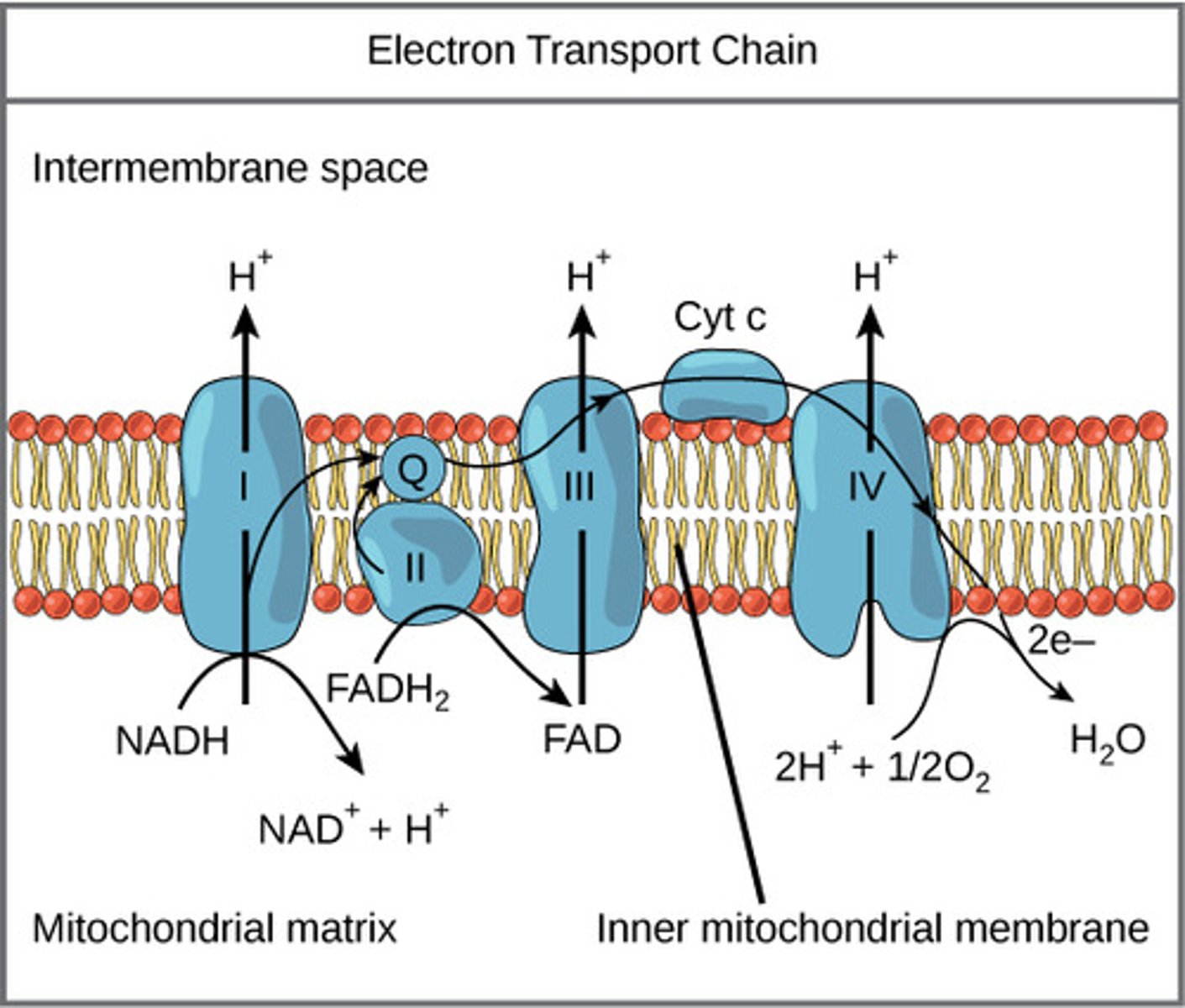
CRB Which of the complexes in the Electron Transport Chain does NOT contribute to Proton Pumping into the Intermembrane space?
(A) Complex I
(B) Complex II
(C) Complex III
(D) Complex IV
(B) Complex II
Complexes I, III and IV all contribute to Proton Pumping.
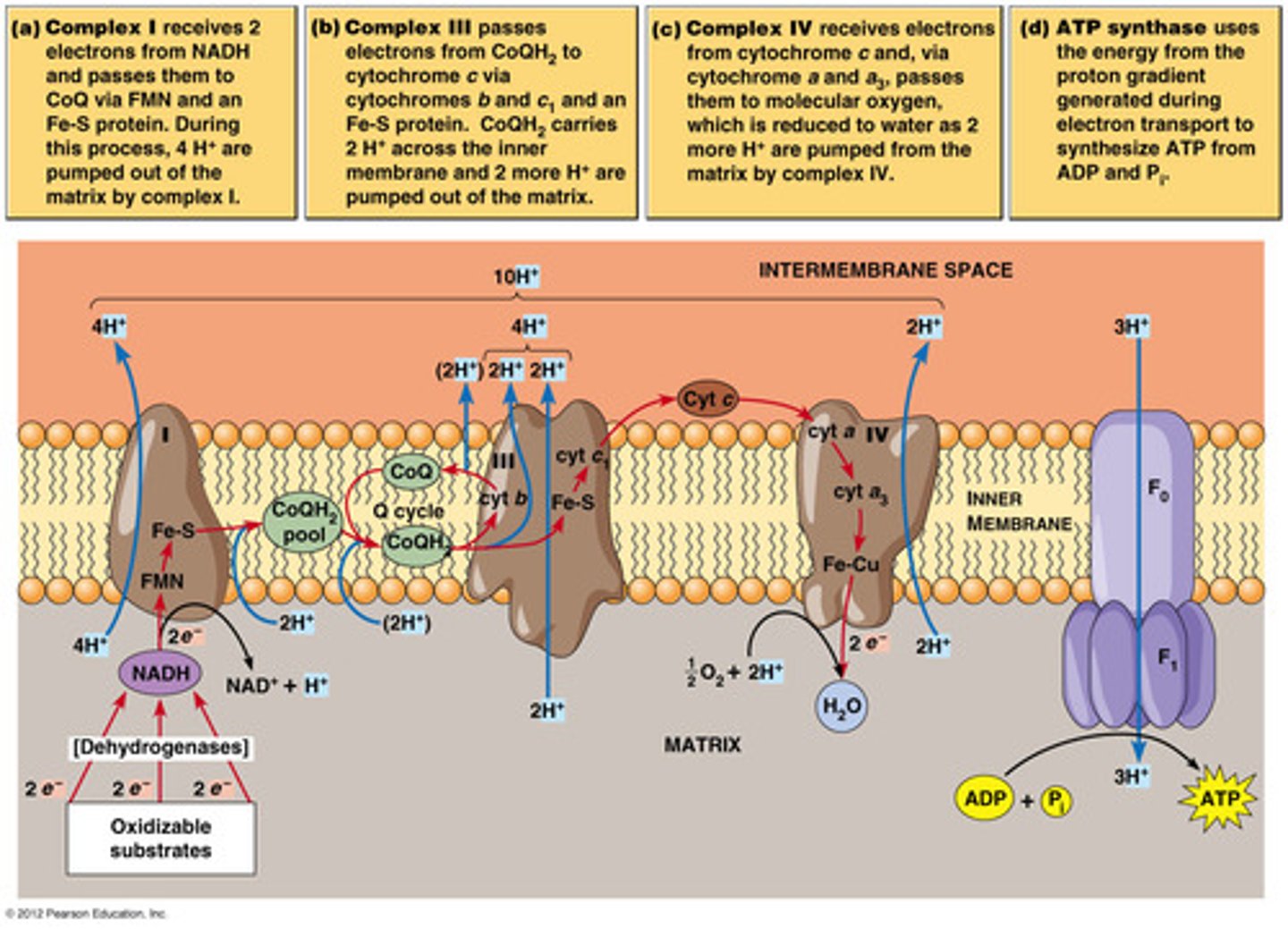
CRB Fill in the blanks: The electrons from Complexes I and II are transferred to _______________, which are later transfered to _______________.
(A) Ubiquinone, Coenzyme Q
(B) Coenzyme Q, Cytochrome C
(C) Cytochrome C, Coenzyme Q
(D) None of the above.
(B) Coenzyme Q, Cytochrome C
The electrons from Complexes I and II are transferred to Coenzyme Q, which are later transfered to Cytochrome C.
Note that Coenzyme Q is synonymous with Ubiquinone.
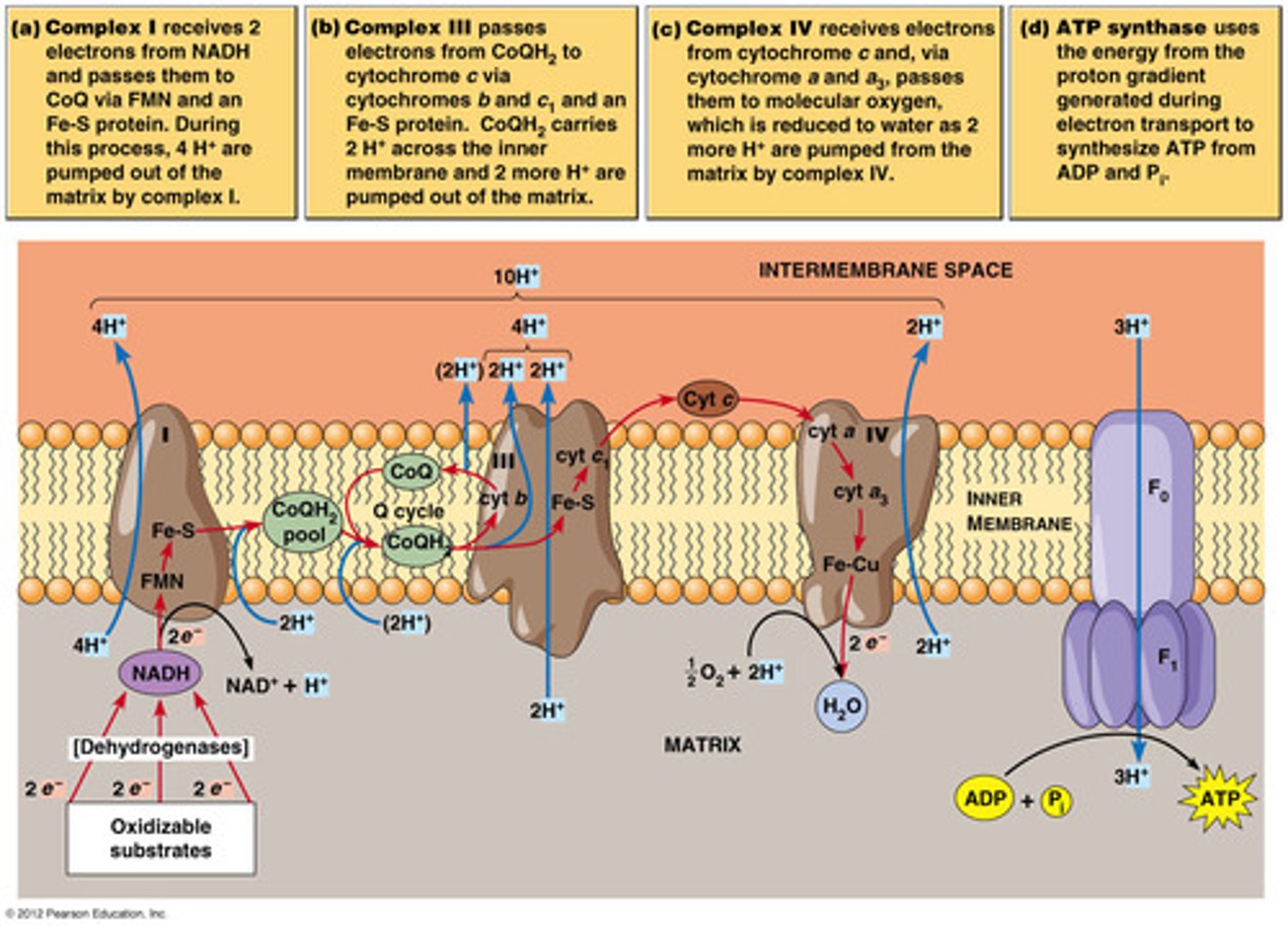
The H+ will then build up in the intermembrane space before travelling back to the matrix through which of the following enzymes?
(A) Lactose permease
(B) Na+/K+ ATPase
(C) ATP Synthase
(D) H+/ADP Antiport
(C) ATP Synthase
The H+ will then build up in the intermembrane space before travelling back to the matrix through ATP Synthase.
Struggling to memorize the metabolic pathways (such as glycolysis and beta-oxidation)? Learn them like the back of your hand using Andrew's Metabolic Pathways Mastery Course @ https://mcatselfprep.com/course/andrews-metabolic-pathways-mastery-course/
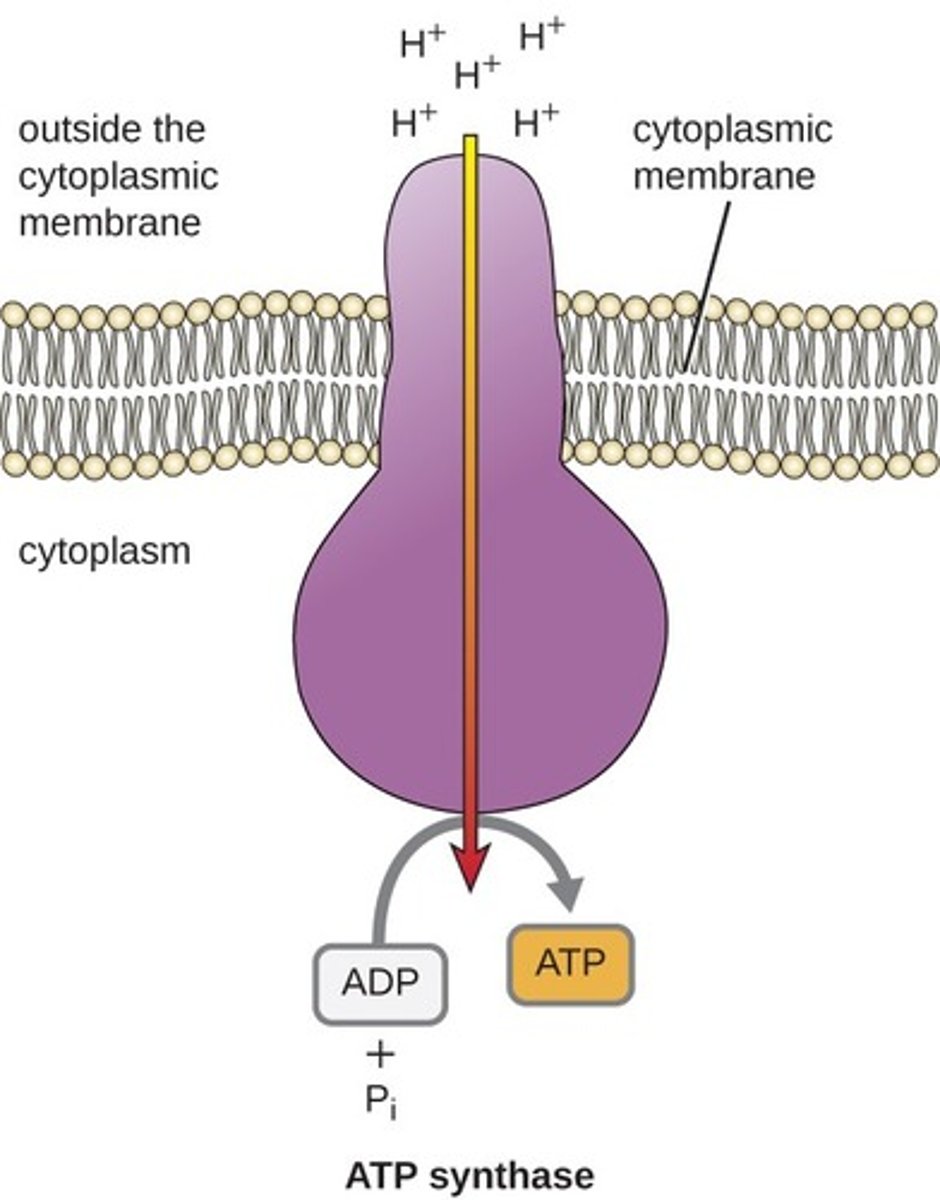
CRB Draw out ATP Synthase, including labeling the F0 Unit, F1 Unit, the proton channel, and the α, β and γ subunits.
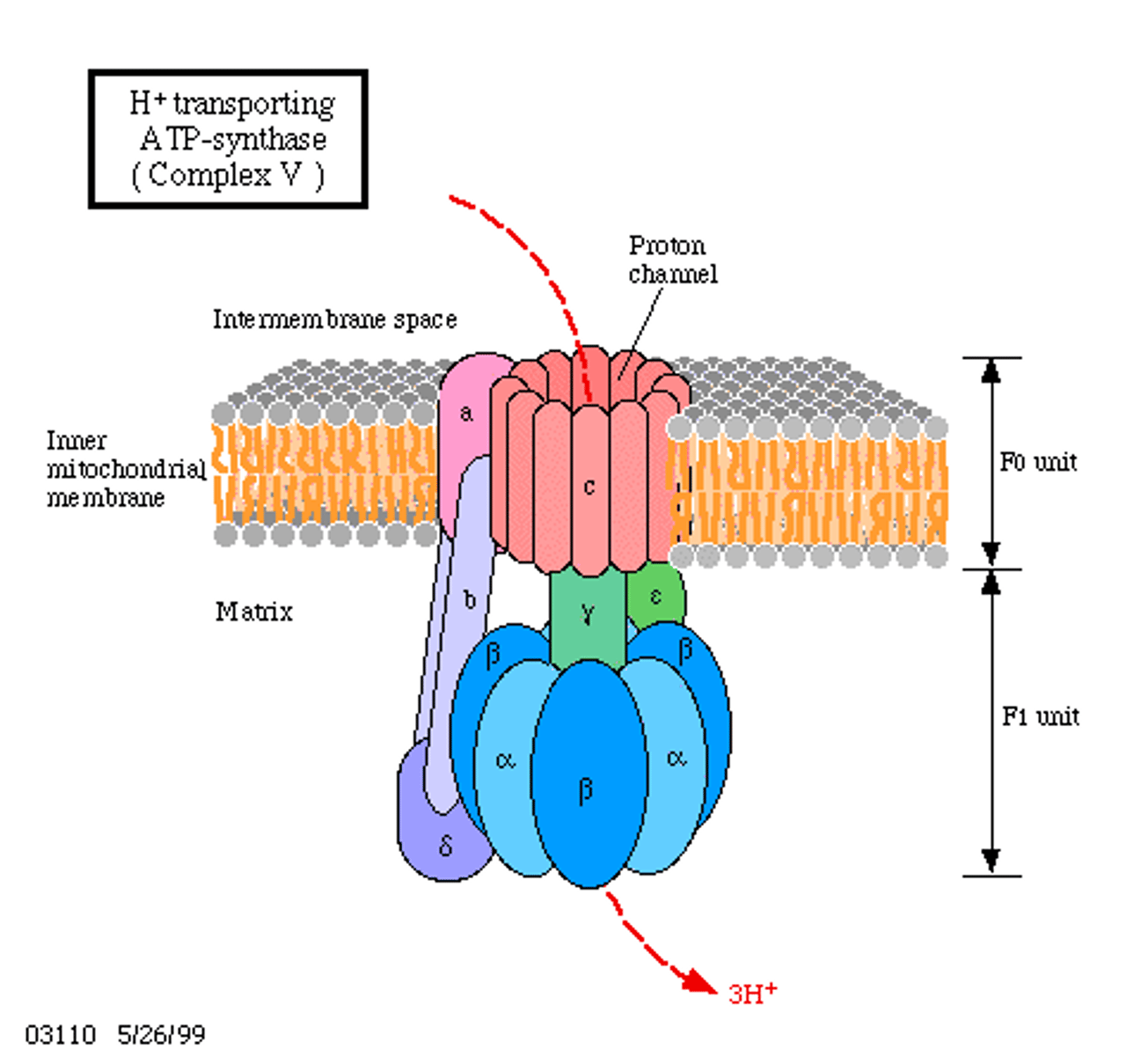
As H+ passes through via a process known as ____________, the axle of ATP synthase spins, resulting in the generation of ATP via the combination of ADP and Pi.
(A) Electromotivation
(B) Chemiosmosis
(C) Oxidative Phosphorylation
(D) H+ Acidosis
(B) Chemiosmosis
As H+ passes through via a process known as chemiosmosis (the movement of chemicals from high to low concentration), the axle of ATP synthase spins, resulting in the generation of ATP via the combination of ADP and Pi.
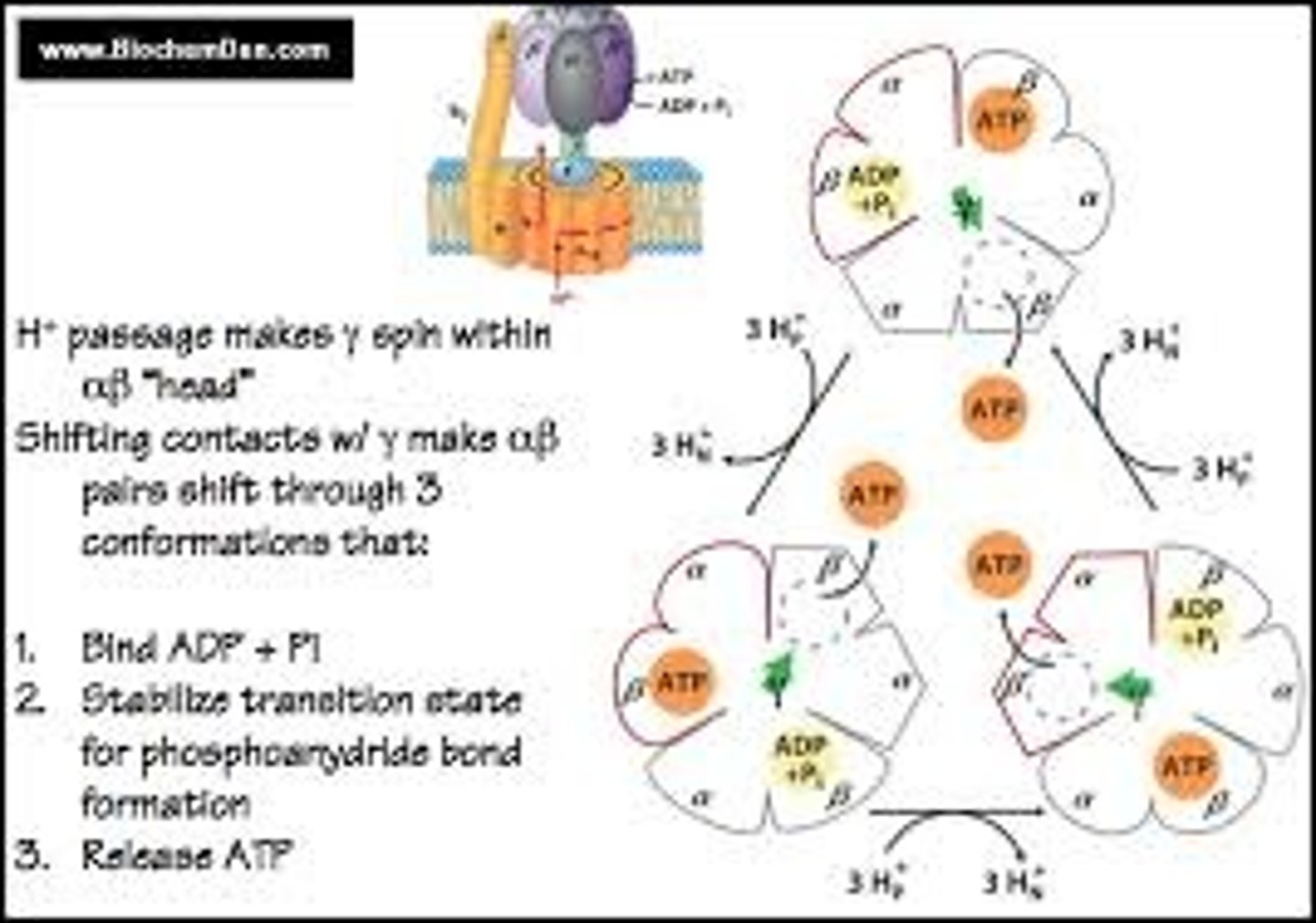
CRB True or false? Chemiosmotic Coupling links the F0 portion's actions (acting as a proton channel) and the F1 portion's actions (Phosphorylating ADP) of ATP Synthase.
True. Chemiosmotic Coupling links the F0 portion's actions (acting as a proton channel) and the F1 portion's actions (Phosphorylating ADP) of ATP Synthase.
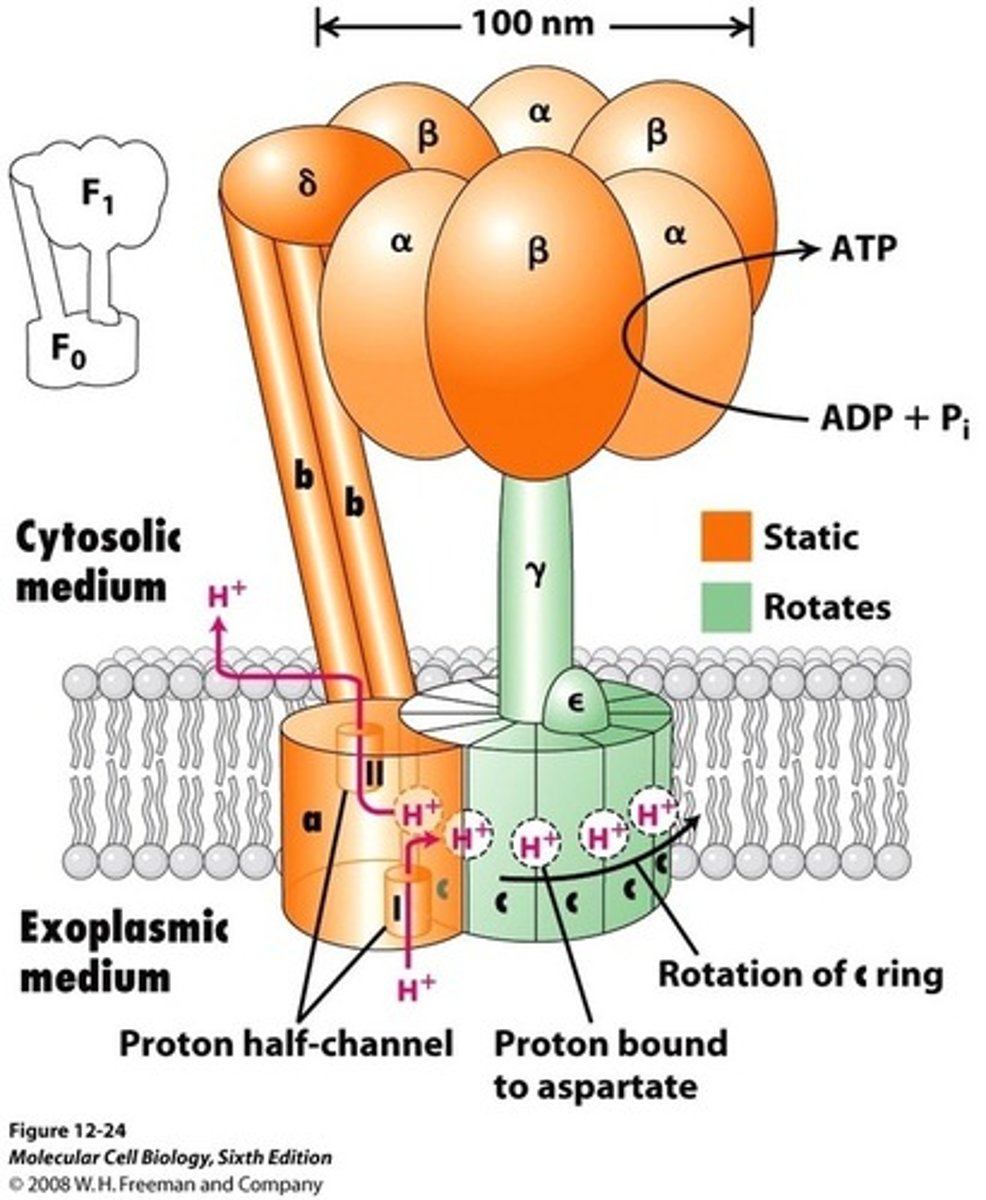
CRB Which of the following is the proper name for the electrochemical proton gradient that is responsible for driving the Chemiosmosis of H+?
(A) The Proton Gradient
(B) The Intermembrane Space Gradient
(C) The Proton-Motive Force
(D) The Proton Electrical Field
(C) The Proton-Motive Force
The Proton-Motive Force is the proper name for the electrochemical proton gradient that is responsible for driving the Chemiosmosis of H+
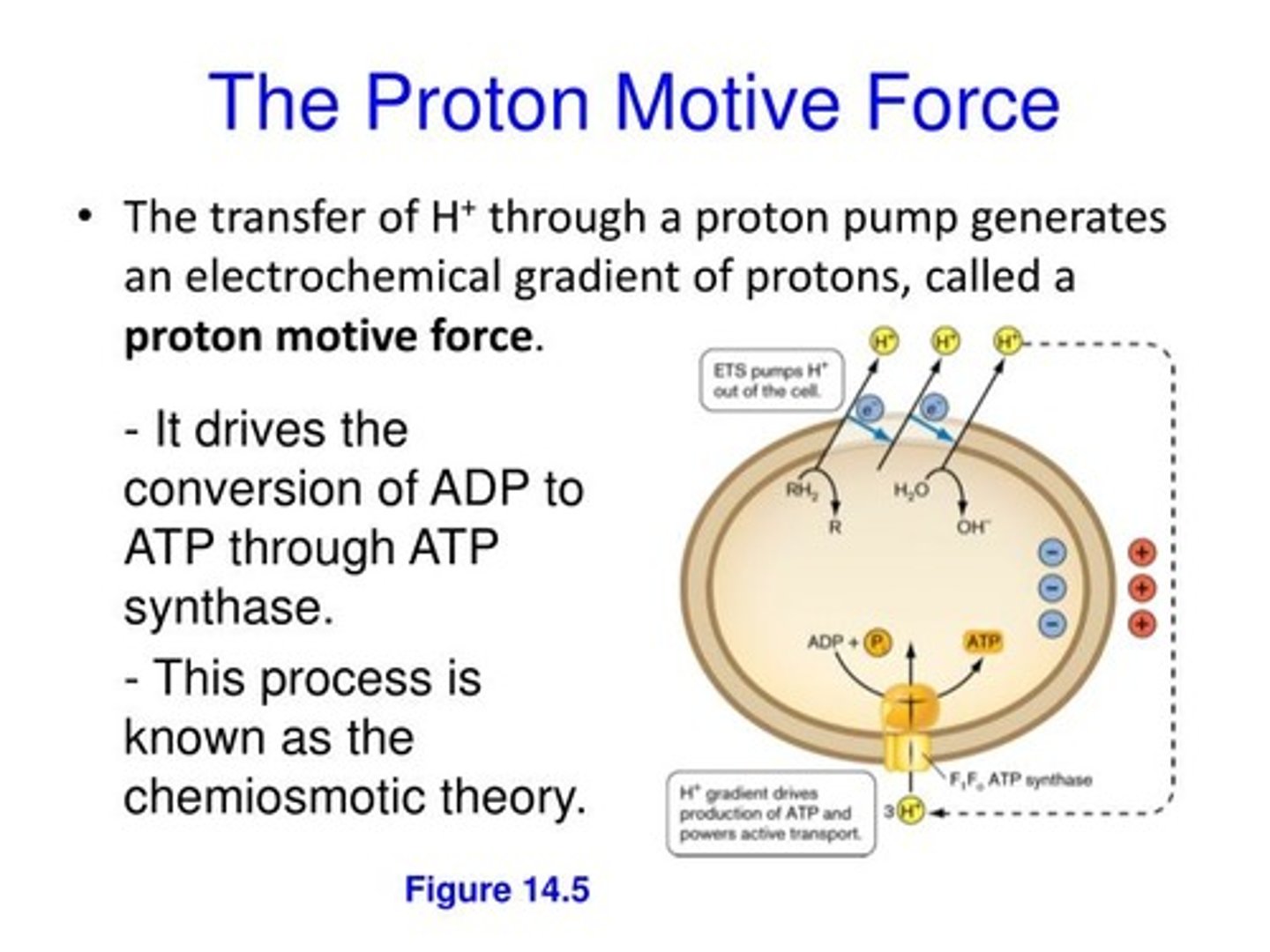
Compare oxidative phosphorylation versus substrate-level phosphorylation.
Oxidative phosphorylation is a very specific name for what occurs during the electron transport chain. It entails the oxidation of electron carrier molecules and the phosphorylation of ADP to form ATP (via ATP synthase).
Substrate phosphorylation is when ATP is generated via a generic enzyme (i.e. pyruvate kinase).

Draw out the steps of the electron transport chain, including all the complexes, electron carrier molecules, key enzymes, and energy substrates.
It is absolutely necessary to be able to do this for the MCAT. And because it is so challenging to memorize all of this point blank, we've created our Metabolic Pathways Mastery Course: https://mcatselfprep.com/course/andrews-metabolic-pathways-mastery-course/
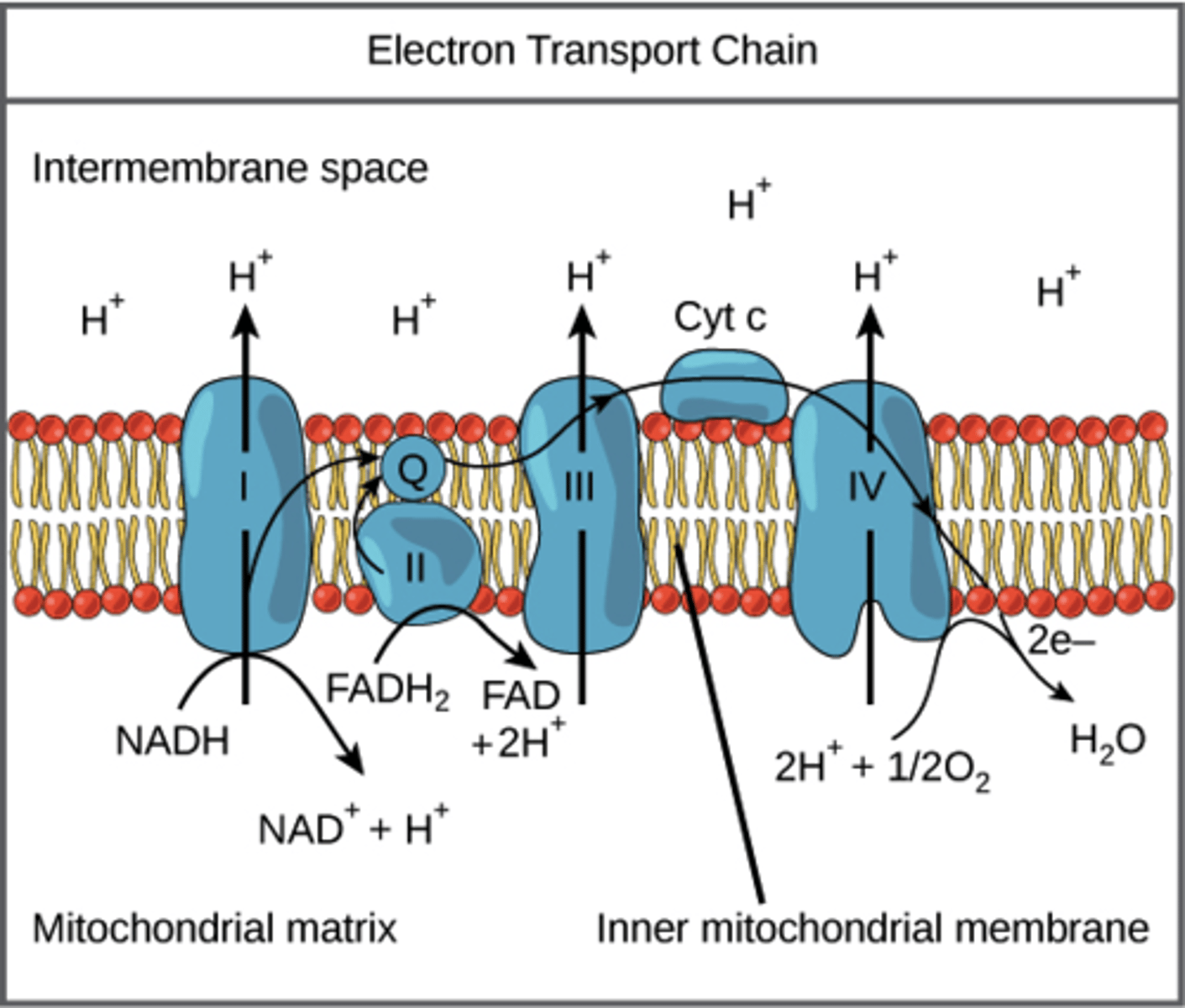
Why isn't the electron transport chain regulated via hormones and/or allosteric regulators?
If NADH and FADH2 are available it will simply do its job. If not, it won't. The availability of NADH and FADH2 are already regulated via the upstream pathways such as glycolysis, the linking step, and the Kreb's cycle. There is no need to "double regulate."
Compare necrosis versus apoptosis.
Apoptosis is controlled cell death that is programmed by the cell. Hence why we call it "programmed cell death."
Necrosis, on the other hand, is uncontrolled and usually due to an infection or some sort of serious cell damage.
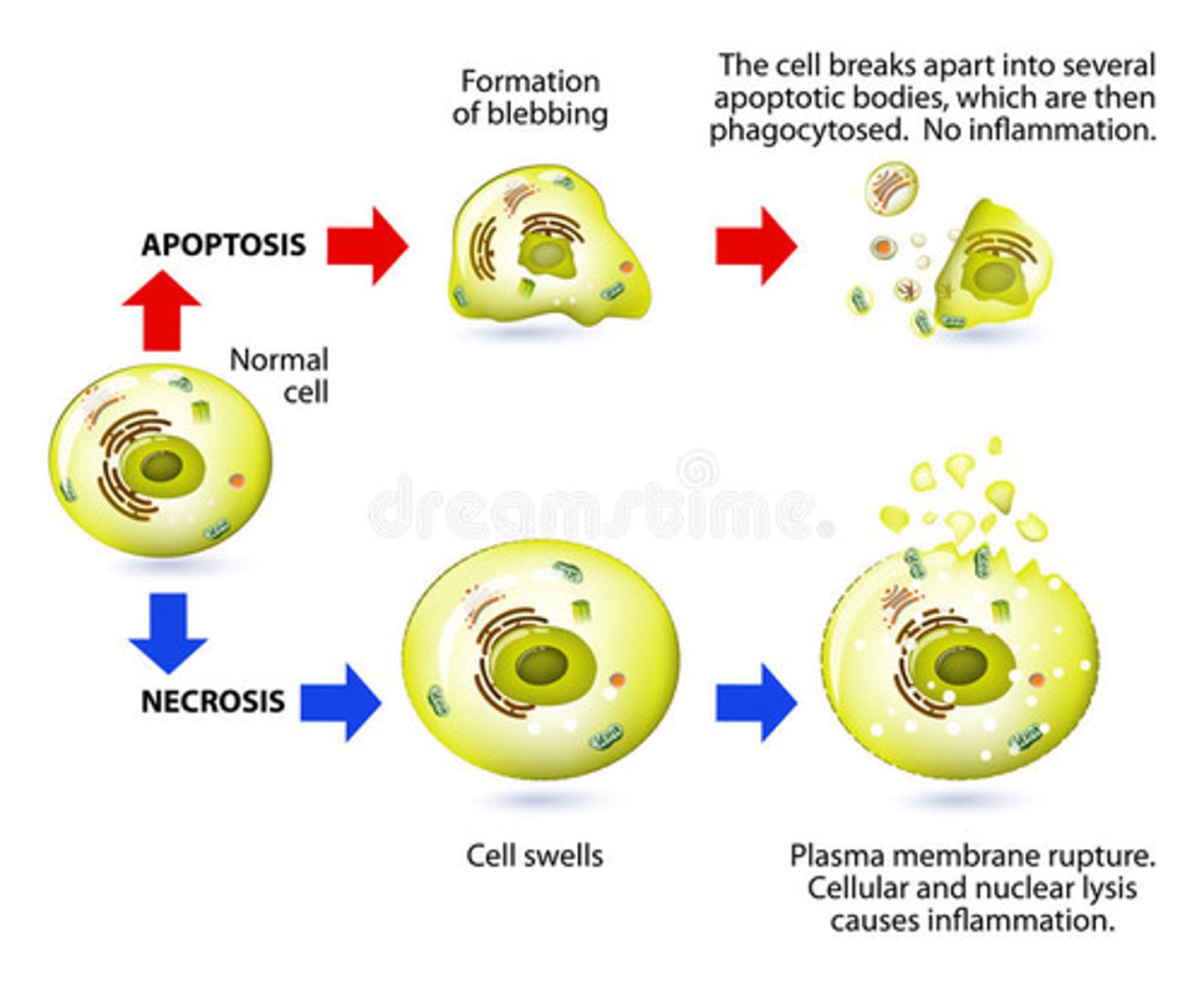
How might apoptosis be useful during development?
Apoptosis can allow us to remove cells that are no longer needed after a certain stage of development. For instance, our fingers and toes develop in a webbed form. Through apoptosis, the web between the fingers and toes can be removed.
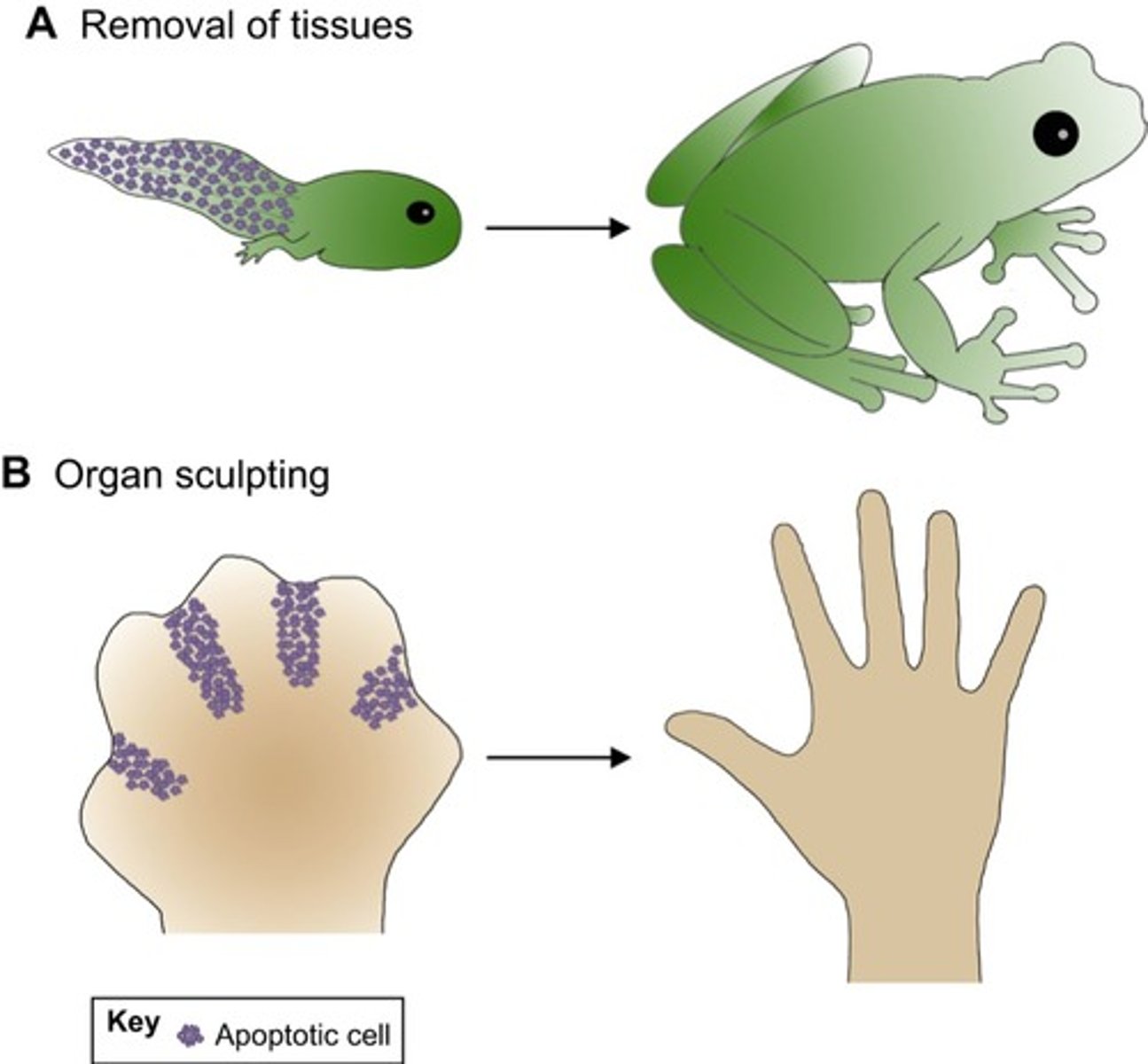
Why is it advantageous if an organism is able to use apoptosis to remove cells with damaged DNA?
Using apoptosis to remove cells with damaged DNA prevents that damaged DNA from being passed on to daughter cells. In particular, some DNA damage may cause cancer, which would result in the rapid growth of cells with damaged DNA. Not good!
Put simply, we want to remove damage and prevent it from spreading.
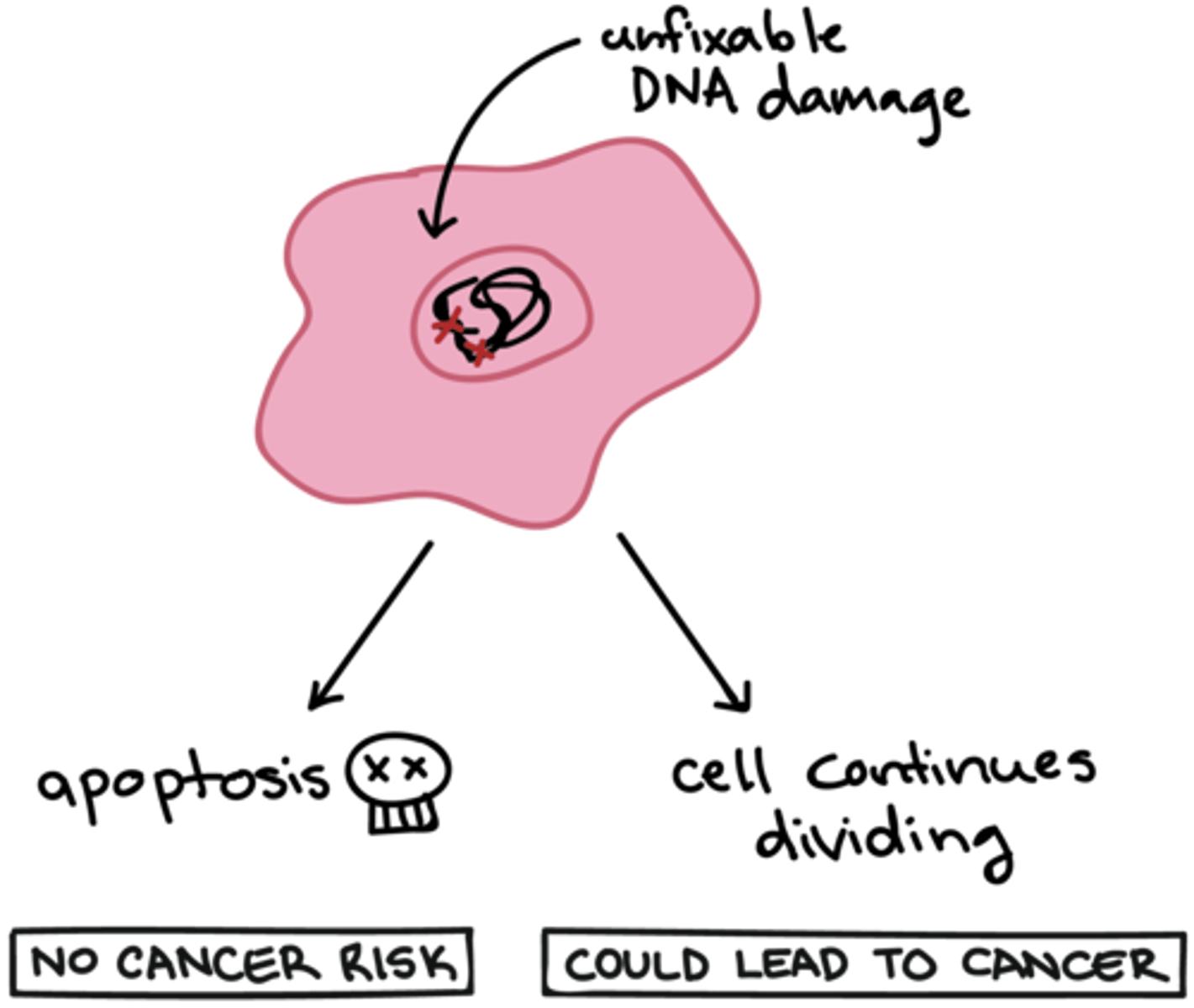
What role might apoptosis play in the immune system?
If a cell gets infected by a virus or pathogen, immune cells may notice this and signal the cell to perform apoptosis, preventing the spread of the disease.
In apoptosis, the outer mitochondrial membrane becomes permeable when the concentration of pro-apoptotic BCL-2 enzymes increases, releasing _____________ from the electron transport chain to go and bind to and activate caspase, which will then orchestrate the apoptosis.
(A) Fe-S Complex
(B) Cyt C
(C) CoQ
(D) H+
(B) Cyt C
In apoptosis, the outer mitochondrial membrane becomes permeable, releasing cytochrome C (Cyt C) from the electron transport chain to go and bind to and activate caspase, which will then orchestrate apoptosis.
Struggling to memorize the metabolic pathways (such as glycolysis and beta-oxidation)? Learn them like the back of your hand using Andrew's Metabolic Pathways Mastery Course @ https://mcatselfprep.com/course/andrews-metabolic-pathways-mastery-course/
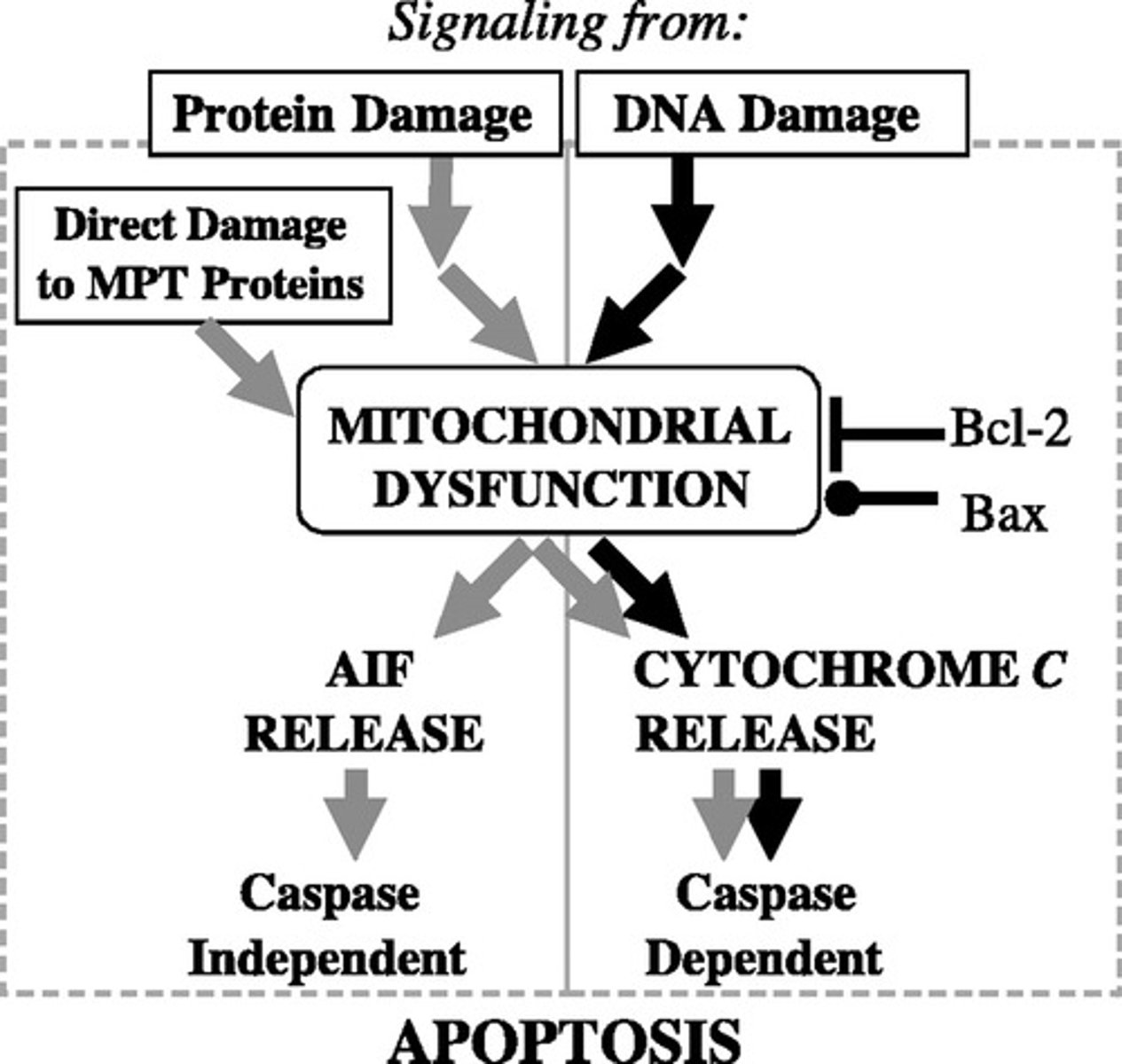
Once caspase is activated, what does it do to cause apoptosis throughout the cell?
Caspase will activate other proteases and nucleases to systematically breakdown the cell.
